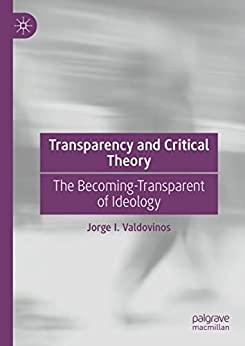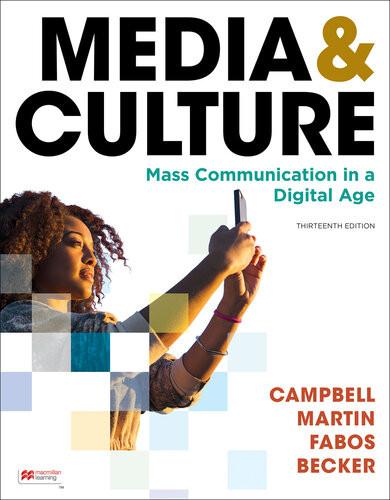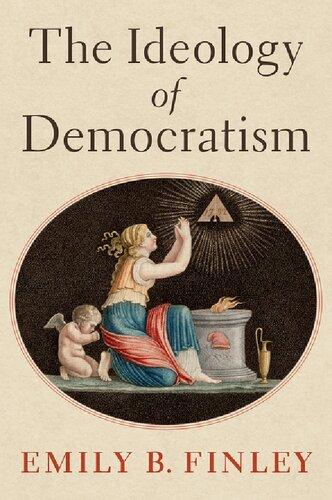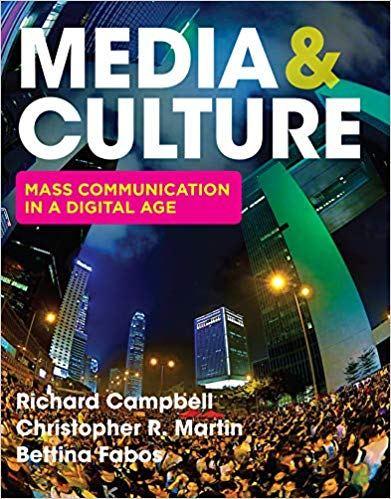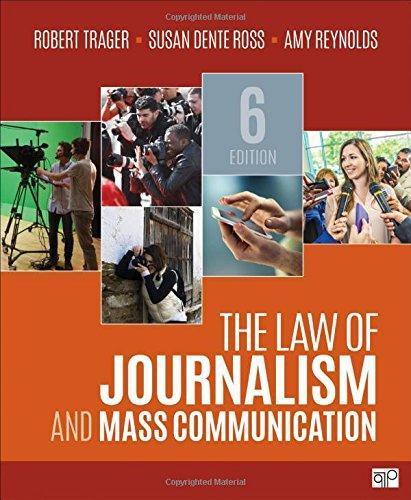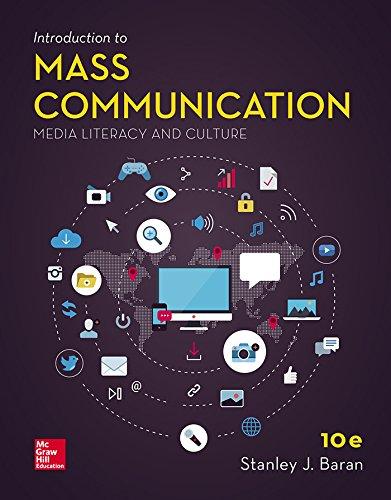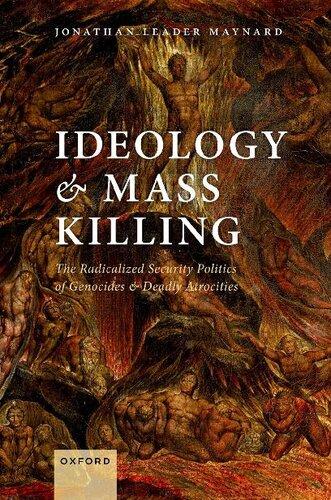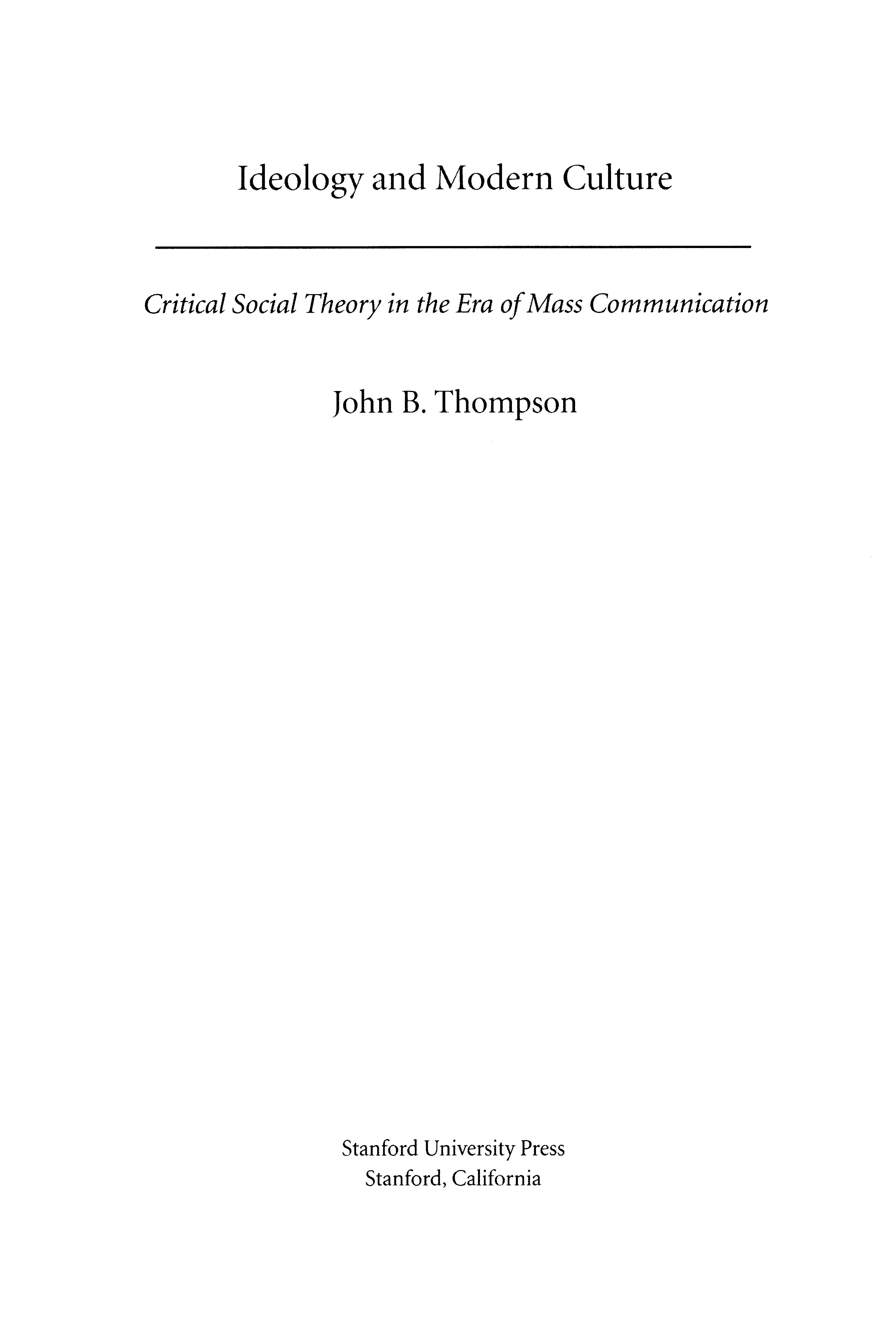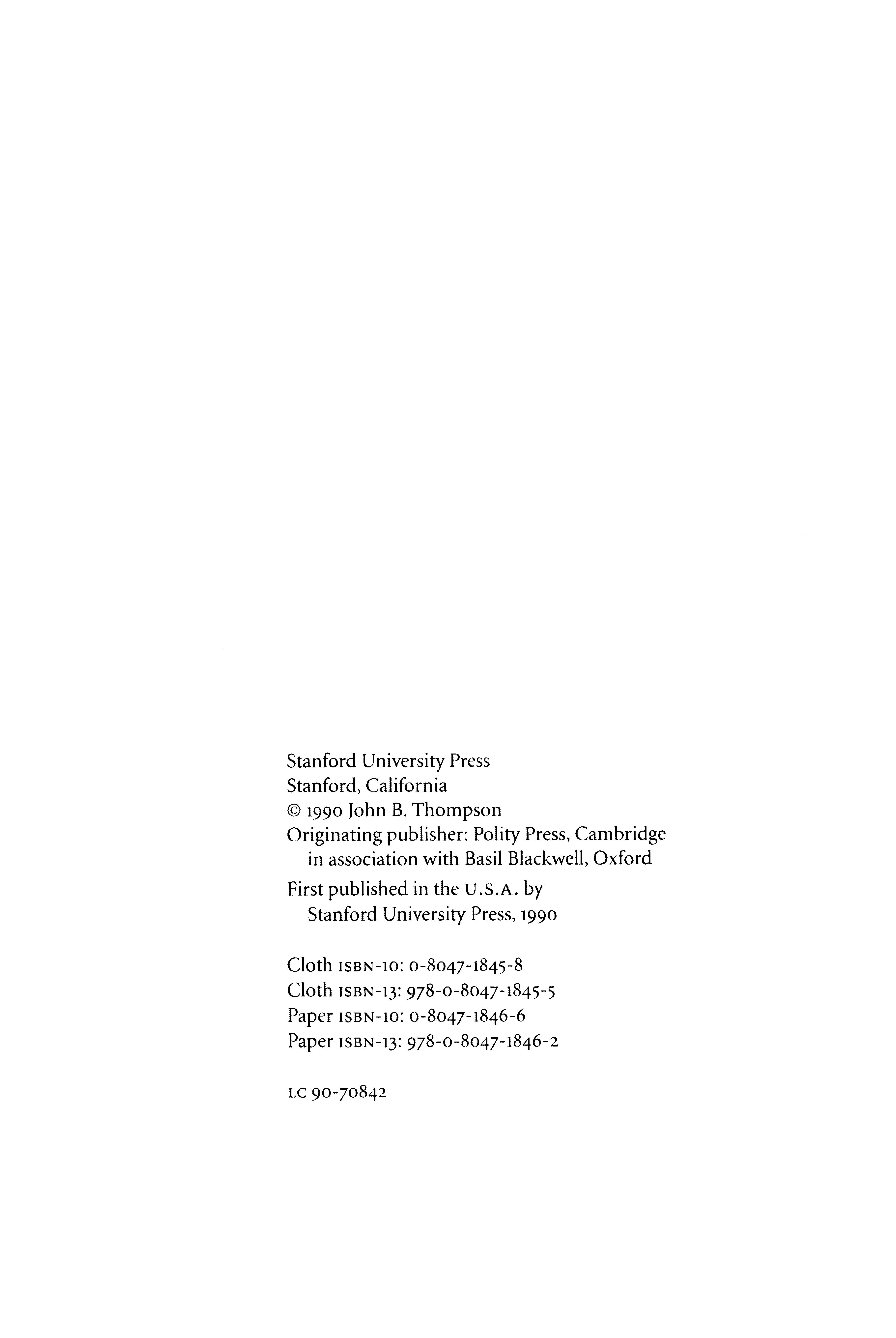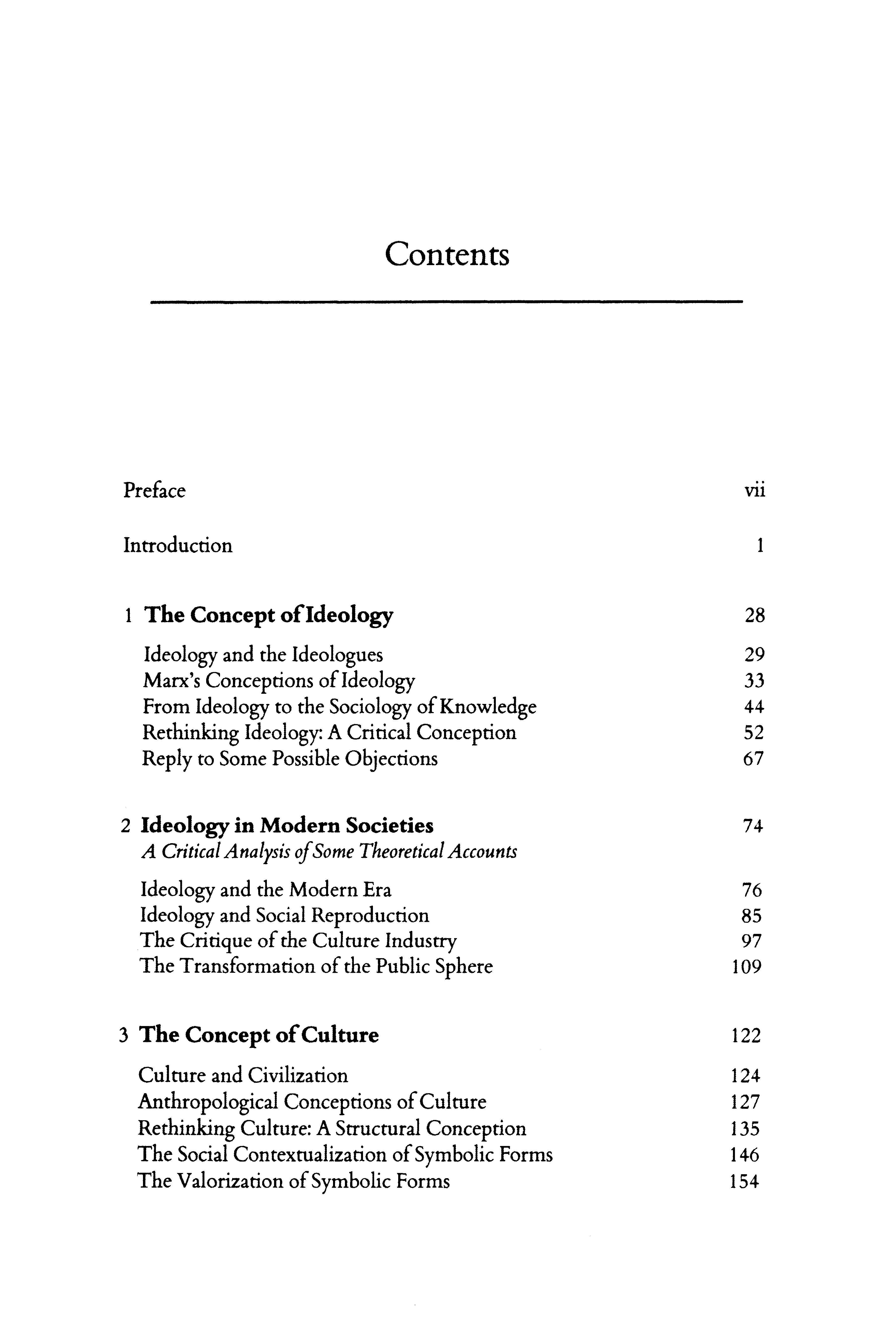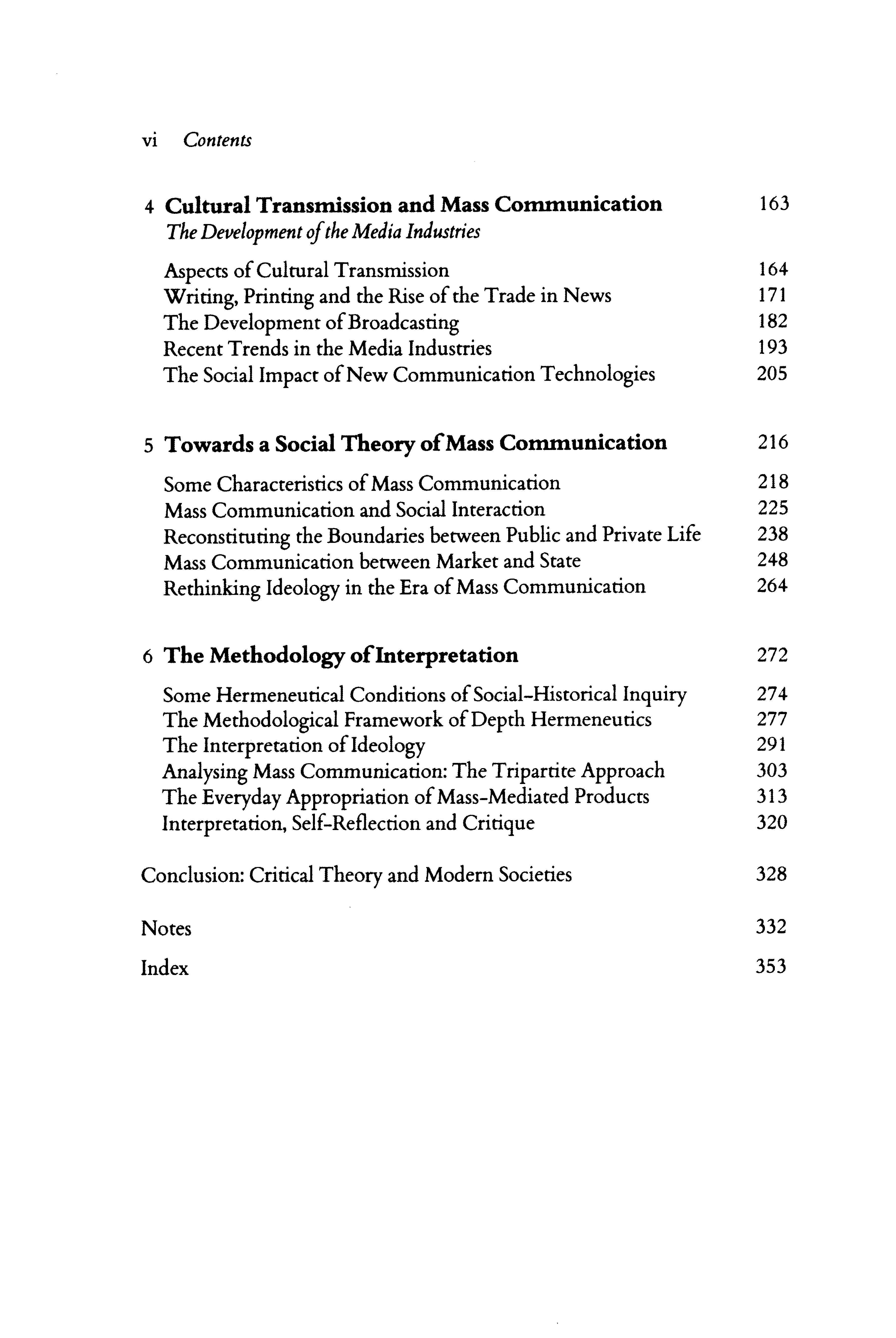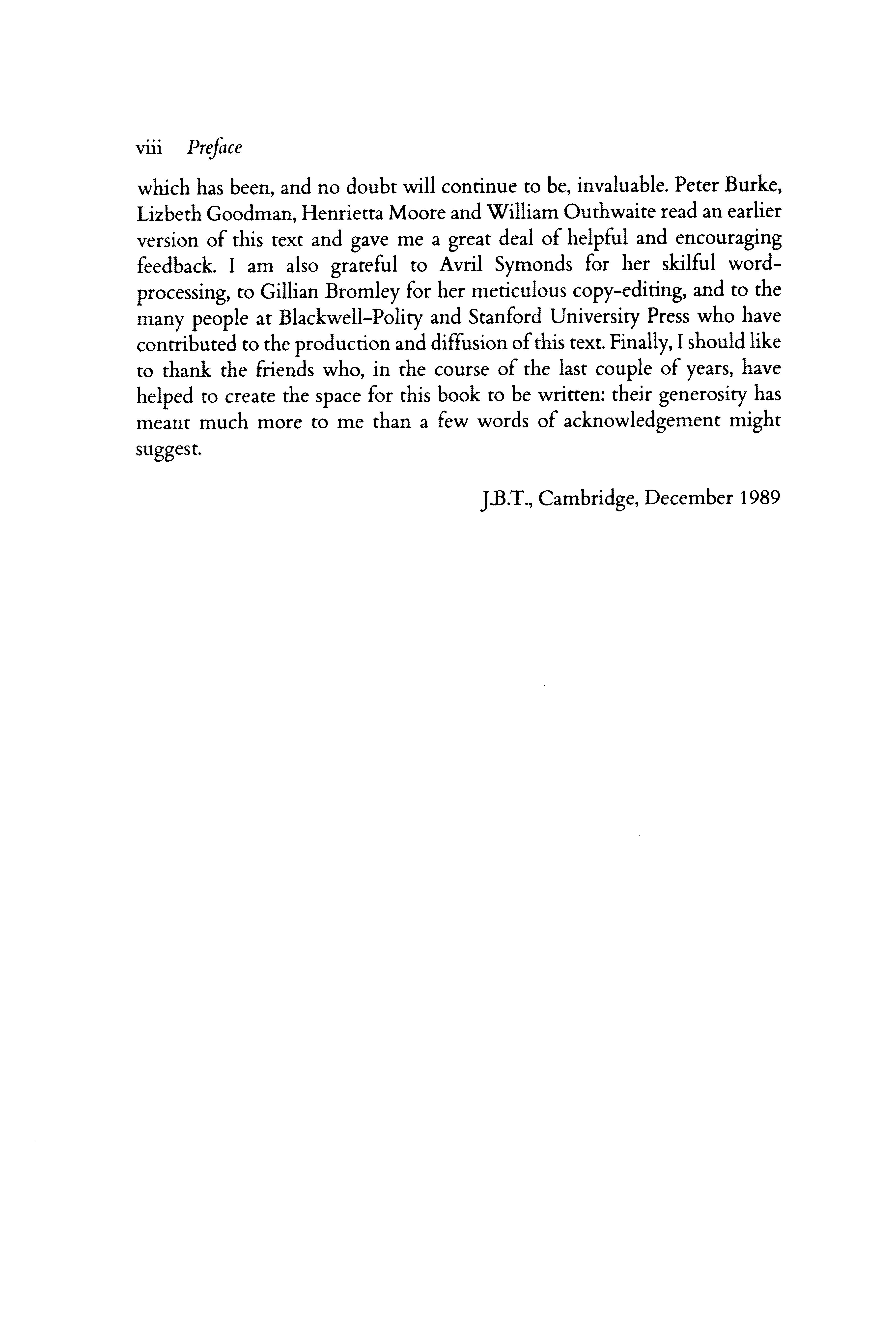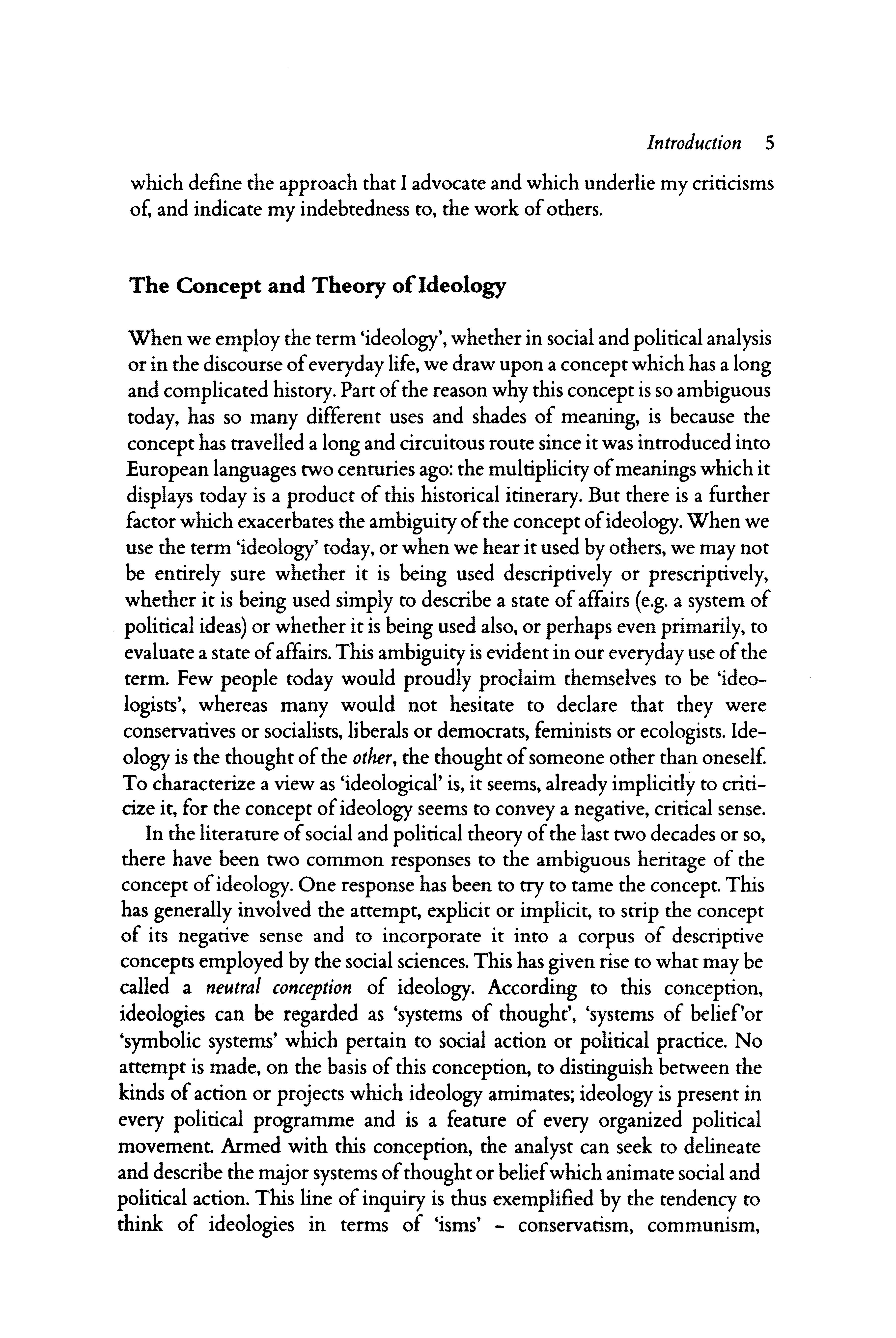Introduction
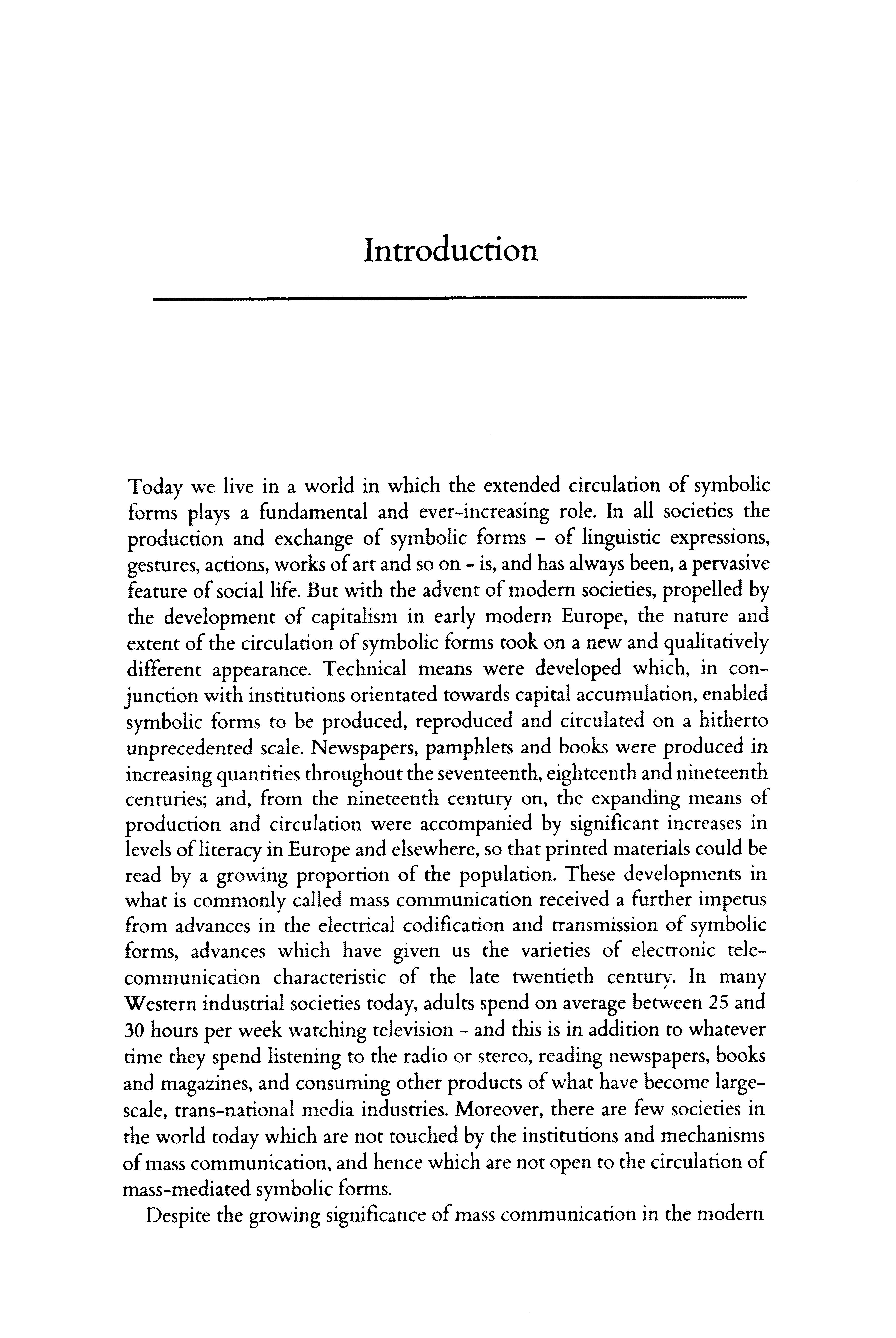
Today we live in a world in which the extended circulation of symbolic forms plays a fundamental and ever-increasing role. In all societies the production and exchange of symbolic forms - of linguistic expressions, gestures, actions, works of art and so on- is, and has always been, a pervasive feature of social life. But with the advent of modern societies, propelled by the development of capitalism in early modern Europe, the nature and extent of the circulation of symbolic forms took on a new and qualitatively different appearance. Technical means were developed which, in conjunction with institutions orientated towards capital accumulation, enabled symbolic forms to be produced, reproduced and circulated on a hitherto unprecedented scale. Newspapers, pamphlets and books were produced in increasing quantities throughout the seventeenth, eighteenth and nineteenth centuries; and. from the nineteenth century on, the expanding means of production and circulation were accompanied by significant increases in levels oflireracy in Europe and elsewhere, so that printed materials could be read by a growing proportion of the population. These developments in what is wmmonly called mass communication received a further impetus from advances in the electrical codification and transmission of symbolic forms, advances which have given us the varieties of electronic telecommunication characteristic of the late twentieth century. In many Western industrial societies today, adults spend on average between 25 and 30 hours per week watching television - and this is in addition to whatever time they spend listening to the radio or stereo, reading newspapers, books and magazines, and consuming other products of what have become largescale, trans-national media industries. Moreover, there are few societies in the world today which are not touched by the institutions and mechanisms of mass communication, and hence which are not open to the circulation of mass-mediated symbolic forms.
Despite the growing significance of mass communication in the modern
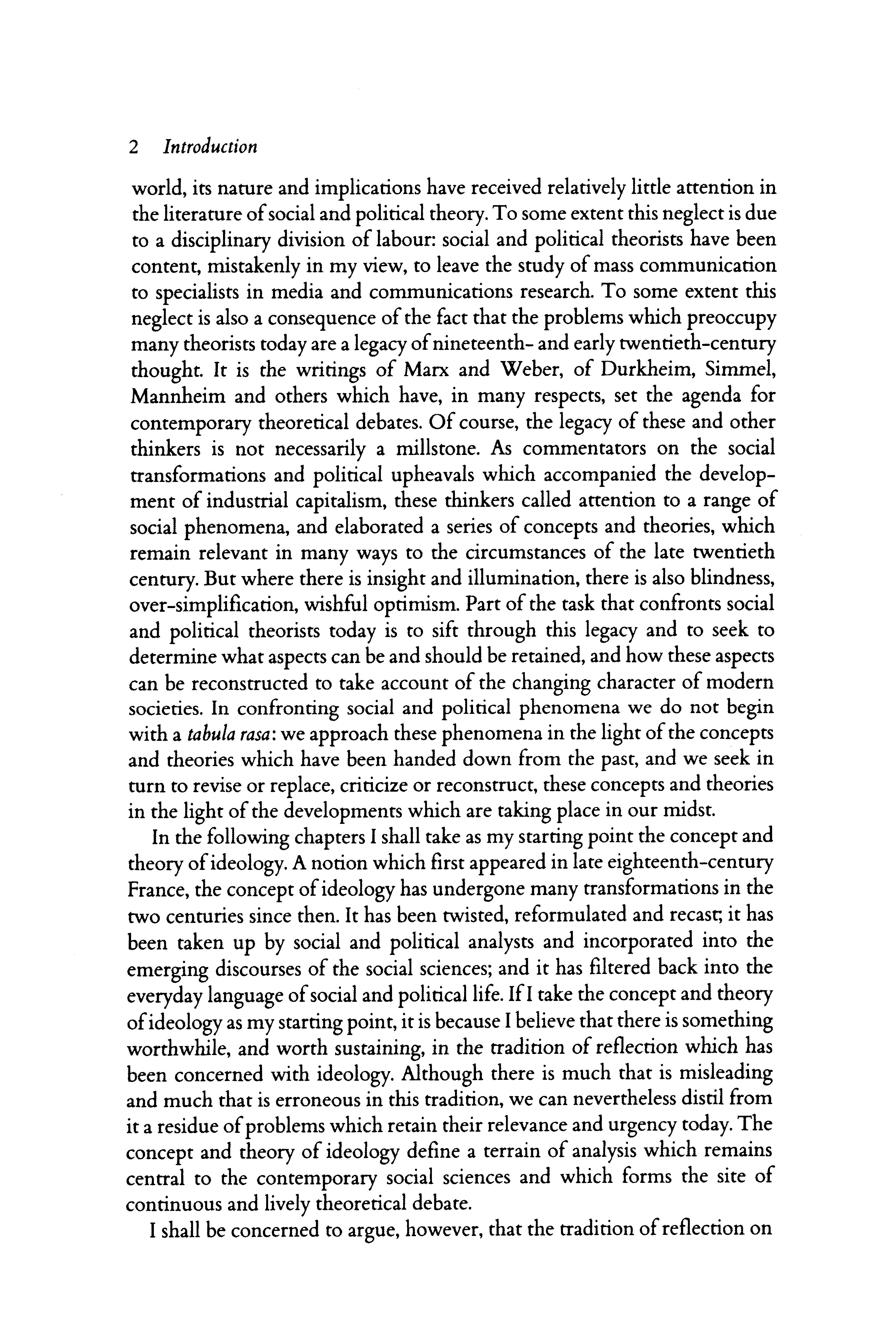
world, its nature and implications have received relatively little attention in the literature of social and political theory. To some extent this neglect is due to a disciplinary division of labour: social and political theorists have been content, mistakenly in my view, to leave the study of mass communication to specialists in media and communications research. To some extent this neglect is also a consequence of the fact that the problems which preoccupy many theorists today are a legacy of nineteenth- and early twentieth-century thought It is the writings of Marx and Weber, of Durkheim, Simmel, Mannheim and others which have, in many respects, set the agenda for contemporary theoretical debates. Of course, the legacy of these and other thinkers is not necessarily a millstone. As commentators on the social transformations and political upheavals which accompanied the development of industrial capitalism, these thinkers called attention to a range of social phenomena, and elaborated a series of concepts and theories, which remain relevant in many ways to the circumstances of the late twentieth century. But where there is insight and illumination, there is also blindness, over-simplification, wishful optimism. Part of the task that confronts social and political theorists today is to sift through this legacy and to seek to determine what aspects can be and should be retained, and how these aspects can be reconstructed to take account of the changing character of modern societies. In confronting social and political phenomena we do not begin with a tabula rasa: we approach these phenomena in the light of the concepts and theories which have been handed down from the past, and we seek in turn to revise or replace, criticize or reconstruct, these concepts and theories in the light of the developments which are taking place in our midst.
In the following chapters I shall take as my starting point the concept and theory of ideology. A notion which first appeared in late eighteenth-century France, the concept of ideology has undergone many transformations in the two centuries since then. It has been twisted, reformulated and recast; it has been taken up by social and political analysts and incorporated into the emerging discourses of the social sciences; and it has filtered back into the everyday language of social and political life. Ifl take the concept and theory of ideology as my starting point, it is because I believe that there is something worthwhile, and worth sustaining, in the tradition of reflection which has been concerned with ideology. Although there is much that is misleading and much that is erroneous in this tradition, we can nevertheless distil from it a residue of problems which retain their relevance and urgency today. The concept and theory of ideology define a terrain of analysis which remains central to the contemporary social sciences and which forms the site of continuous and lively theoretical debate.
I shall be concerned to argue, however, that the tradition of reflection on
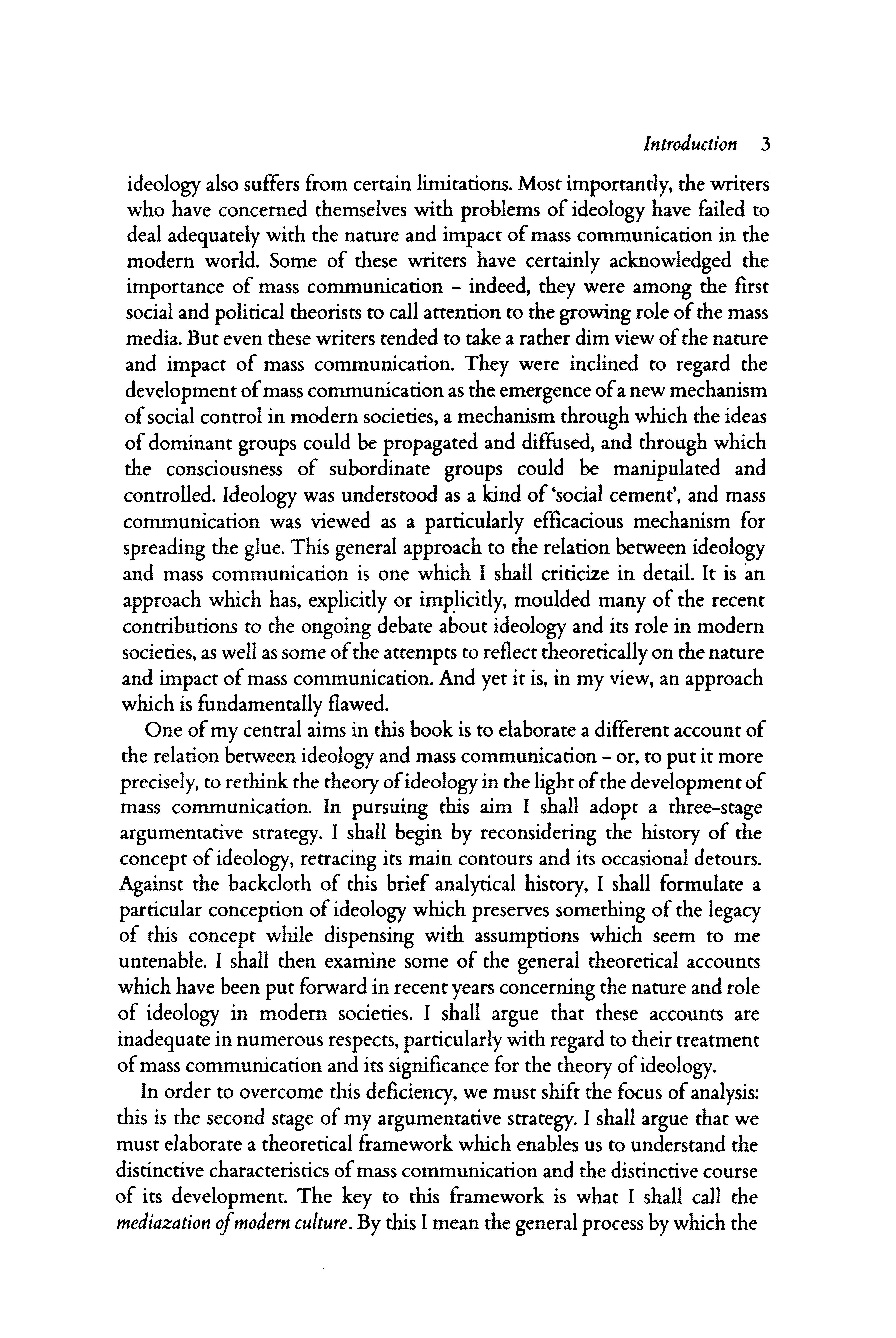
ideology also suffers from certain limitations. Most importantly, the writers who have concerned themselves with problems of ideology have failed to deal adequately with the nature and impact of mass communication in the modern world. Some of these writers have certainly acknowledged the importance of mass communication - indeed, they were among the first social and political theorists to call attention to the growing role of the mass media. But even these writers tended to take a rather dim view of the nature and impact of mass communication. They were inclined to regard the development of mass communication as the emergence of a new mechanism of social control in modern societies, a mechanism through which the ideas of dominant groups could be propagated and diffused, and through which the consciousness of subordinate groups could be manipulated and controlled. Ideology was understood as a kind of 'social cement', and mass communication was viewed as a particularly efficacious mechanism for spreading the glue. This general approach to the relation between ideology and mass communication is one which I shall criticize in detail. It is an approach which has, explicitly or imp,licidy, moulded many of the recent contributions to the ongoing debate about ideology and its role in modern societies, as well as some of the attempts to reflect theoretically on the nature and impact of mass communication. And yet it is, in my view, an approach which is fundamentally flawed.
One of my central aims in this book is to elaborate a different account of the relation between ideology and mass communication - or, to put it more precisely, to rethink the theory of ideology in the light of the development of mass communication. In pursuing this aim I shall adopt a three-stage argumentative strategy. I shall begin by reconsidering the history of the concept of ideology, retracing its main contours and its occasional detours. Against the backcloth of this brief analytical history, I shall formulate a particular conception of ideology which preserves something of the legacy of this concept while dispensing with assumptions which seem to me untenable. I shall then examine some of the general theoretical accounts which have been put forward in recent years concerning the nature and role of ideology in modern societies. I shall argue that these accounts are inadequate in numerous respects, particularly with regard to their treatment of mass communication and its significance for the theory of ideology.
In order to overcome this deficiency, we must shift the focus of analysis: this is the second stage of my argumentative strategy. I shall argue that we must elaborate a theoretical framework which enables us to understand the distinctive characteristics of mass communication and the distinctive course of its development. The key to this framework is what I shall call the mediazation ofmodern culture. By this I mean the general process by which the
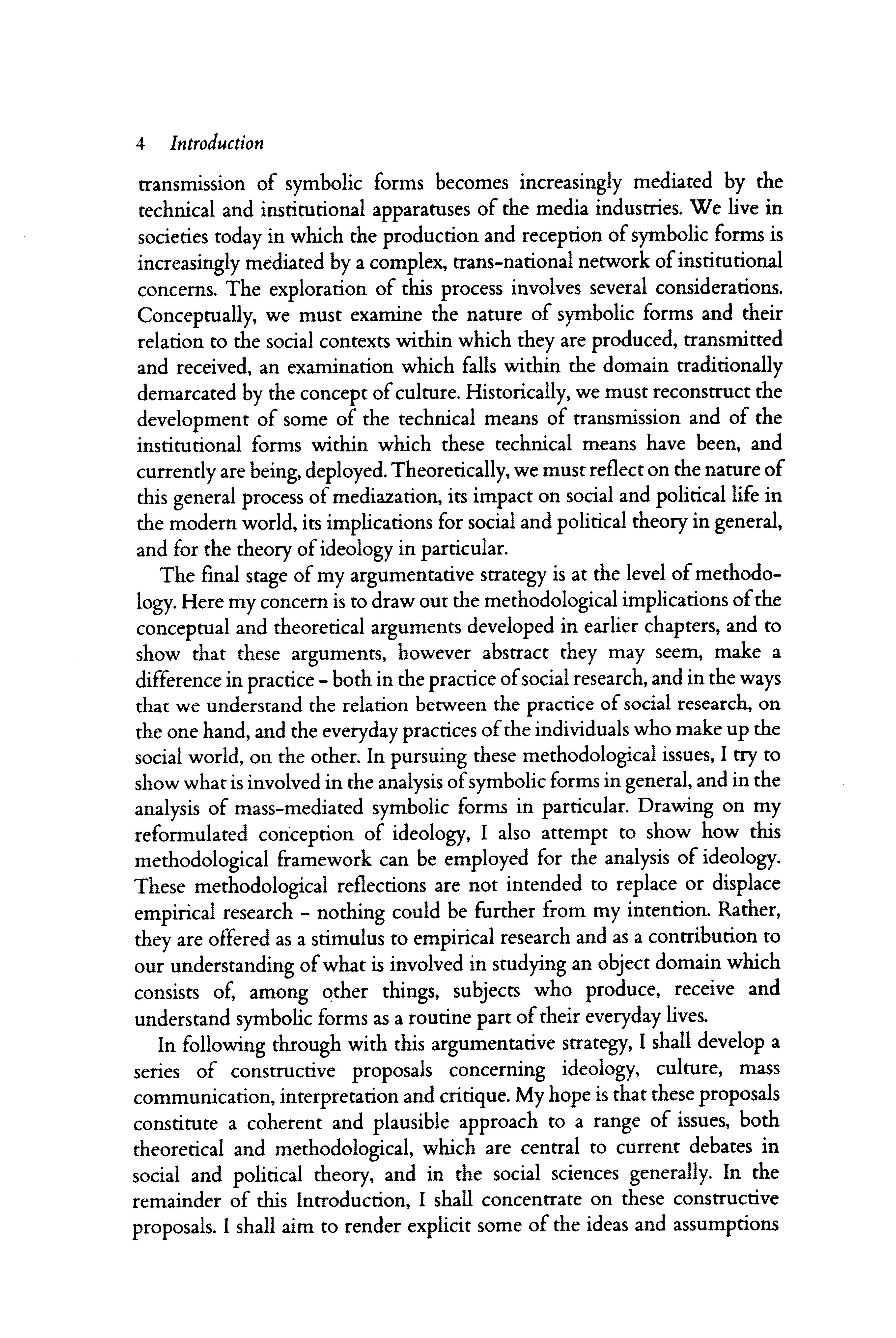
transmission of symbolic forms becomes increasingly mediated by the technical and institutional apparatuses of the media industries. We live in societies today in which the production and reception of symbolic forms is increasingly mediated by a complex, trans-national network of institutional concerns. The exploration of this process involves several considerations. Conceptually, we must examine the nature of symbolic forms and their relation to the social contexts within which they are produced, transmitted and received, an examination which falls within the domain traditionally demarcated by the concept of culture. Historically, we must reconstruct the development of some of the technical means of transmission and of the institutional forms within which these technical means have been, and currently are being, deployed. Theoretically, we must reflect on the nature of this general process of mediazation, its impact on social and political life in the modern world, its implications for social and political theory in general, and for the theory of ideology in particular.
The final stage of my argumentative strategy is at the level of methodology. Here my concern is to draw out the methodological implications of the conceptual and theoretical arguments developed in earlier chapters, and to show that these arguments, however abstract they may seem, make a difference in practice- both in the practice of social research, and in the ways that we understand the relation between the practice of social research, on the one hand, and the everyday practices of the individuals who make up the social world, on the other. In pursuing these methodological issues, I try to show what is involved in the analysis of symbolic forms in general, and in the analysis of mass-mediated symbolic forms in particular. Drawing on my reformulated conception of ideology, I also attempt to show how this methodological framework can be employed for the analysis of ideology. These methodological reflections are not intended to replace or displace empirical research - nothing could be further from my intention. Rather, they are offered as a stimulus to empirical research and as a contribution to our understanding of what is involved in studying an object domain which consists of, among qther things, subjects who produce, receive and understand symbolic forms as a routine part of their everyday lives.
In following through with this argumentative strategy, I shall develop a series of constructive proposals concerning ideology, culture, mass communication, interpretation and critique. My hope is that these proposals constitute a coherent and plausible approach to a range of issues, both theoretical and methodological, which are central to current debates in social and political theory, and in the social sciences generally. In the remainder of this Introduction, I shall concentrate on these constructive proposals. I shall aim to render explicit some of the ideas and assumptions
which define the approach that I advocate and which underlie my criticisms of, and indicate my indebtedness to, the work of others.
The Concept and Theory ofldeology
When we employ the term 'ideology', whether in social and political analysis or in the discourse of everyday life, we draw upon a concept which has a long and complicated history. Part of the reason why this concept is so ambiguous today, has so many different uses and shades of meaning, is because the concept has travelled a long and circuitous route since it was introduced into European languages two centuries ago: the multiplicity of meanings which it displays today is a product of this historical itinerary. But there is a further factor which exacerbates the ambiguity of the concept of ideology. When we use the term 'ideology' today, or when we hear it used by others, we may not be entirely sure whether it is being used descriptively or prescriptively, whether it is being used simply to describe a state of affairs (e.g. a system of political ideas) or whether it is being used also, or perhaps even primarily, to evaluate a state of affairs. This ambiguity is evident in our everyday use of the term. Few people today would proudly proclaim themselves to be 'ideologists', whereas many would not hesitate to declare that they were conservatives or socialists, liberals or democrats, feminists or ecologists. Ideology is the thought of the other, the thought of someone other than onesel£ To characterize a view as 'ideological' is, it seems, already implicitly to criticize it, for the concept of ideology seems to convey a negative, critical sense.
In the literature of social and political theory of the last two decades or so, there have been two common responses to the ambiguous heritage of the concept of ideology. One response has been to try to tame the concept. This has generally involved the attempt, explicit or implicit, to strip the concept of its negative sense and to incorporate it into a corpus of descriptive concepts employed by the social sciences. This has given rise to what may be called a neutral conception of ideology. According to this conception, ideologies can be regarded as 'systems of thought', 'systems of belief'or 'symbolic systems' which pertain to social action or political practice. No attempt is made, on the basis of this conception, to distinguish between the kinds of action or projects which ideology amimates; ideology is present in every political programme and is a feature of every organized political movement. Armed with this conception, the analyst can seek to delineate and describe the major systems of thought or belief which animate social and political action. This line of inquiry is thus exemplified by the tendency to think of ideologies in terms of 'isms' - conservatism, communism,
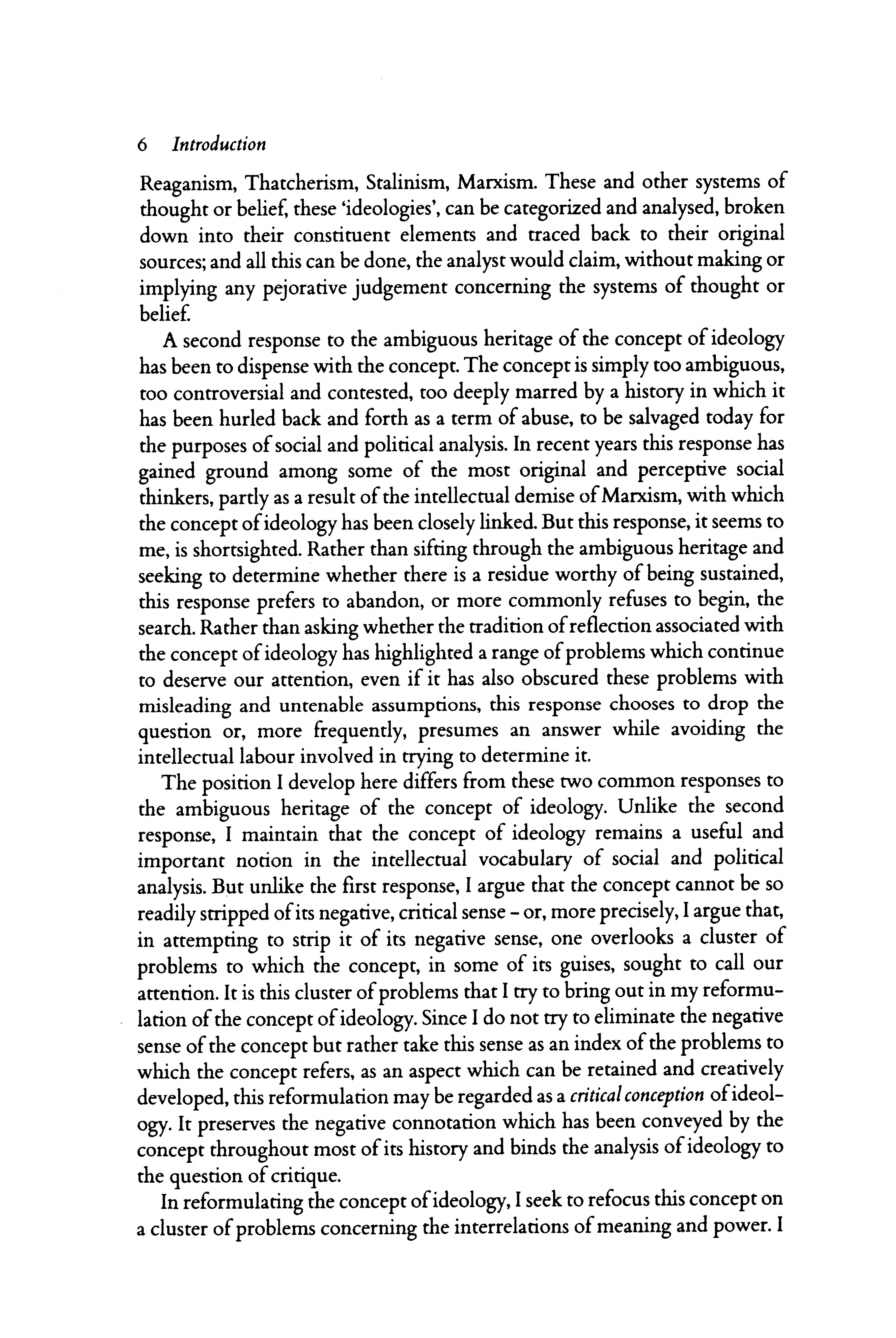
Reaganism, Thatcherism, Stalinism, Marxism. These and other systems of thought or belief, these 'ideologies', can be categorized and analysed, broken down into their constituent elements and traced back to their original sources; and all this can be done, the analyst would claim, without making or implying any pejorative judgement concerning the systems of thought or belie£
A second response to the ambiguous heritage of rhe concept of ideology has been to dispense with the concept. The concept is simply too ambiguous, too controversial and contested, too deeply marred by a history in which it has been hurled back and forth as a term of abuse, to be salvaged today for the purposes of social and political analysis. In recent years this response has gained ground among some of the most original and perceptive social thinkers, partly as a result of the intellectual demise of Marxism, with which the concept ofideology has been closely linked. But this response, it seems to me, is shortsighted. Rather than sifting through the ambiguous heritage and seeking to determine whether there is a residue worthy of being sustained, this response prefers to abandon, or more commonly refuses to begin, the search. Rather than asking whether the tradition of reflection associated with the concept of ideology has highlighted a range of problems which continue ro deserve our attention, even if it has also obscured these problems with misleading and untenable assumptions, this response chooses to drop the question or, more frequently, presumes an answer while avoiding the intellectual labour involved in trying to determine it.
The position I develop here differs from these two common responses to the ambiguous heritage of the concept of ideology. Unlike the second response, I maintain that rhe concept of ideology remains a useful and important notion in the intellectual vocabulary of social and political analysis. But unlike the first response, I argue that the concept cannot be so readily stripped of its negative, critical sense- or, more precisely, I argue that, in attempting to strip it of its negative sense, one overlooks a cluster of problems to which the concept, in some of its guises, sought to call our attention. It is chis cluster of problems that I try to bring out in my reformulation of the concept of ideology. Since I do not try to eliminate the negative sense of the concept bur rather rake this sense as an index of rhe problems to which the concept refers, as an aspect which can be retained and creatively developed, this reformulation may be regarded as a critical conception of ideology. It preserves the negative connotation which has been conveyed by rhe concept throughout most of its history and binds the analysis of ideology to the question of critique.
In reformulating the concept of ideology, I seek to refocus this concept on a cluster of problems concerning the interrelations of meaning and power. I
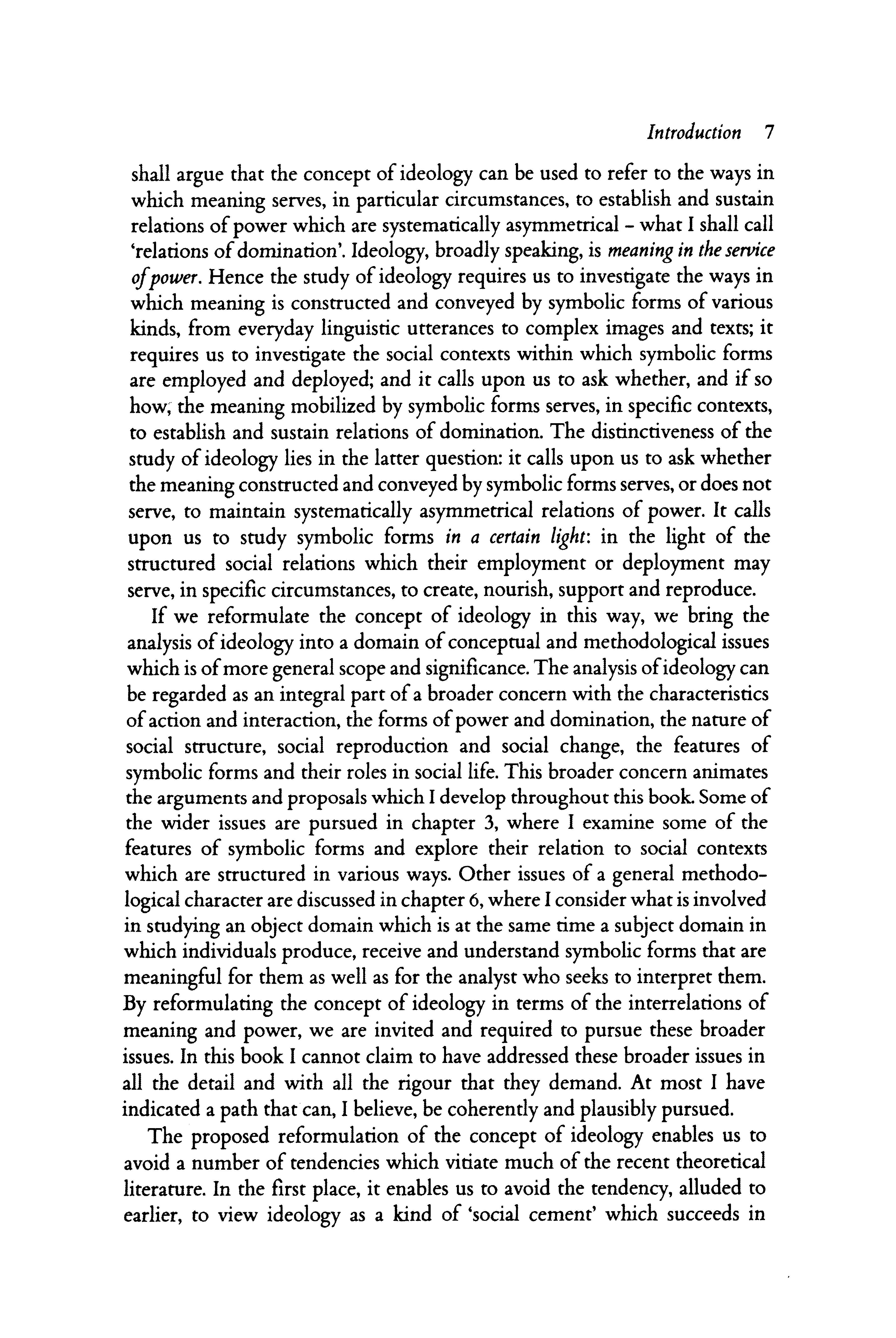
shall argue that the concept of ideology can be used to refer to the ways in which meaning serves, in particular circumstances, to establish and sustain relations of power which are systematically asymmetrical - what I shall call 'relations of domination'. Ideology, broadly speaking, is meaning in the service ofpower. Hence the study of ideology requires us to investigate the ways in which meaning is constructed and conveyed by symbolic forms of various kinds, from everyday linguistic utterances to complex images and texts; it requires us to investigate the social contexts within which symbolic forms are employed and deployed; and it calls upon us to ask whether, and if so how; the meaning mobilized by symbolic forms serves, in specific contexts, to establish and sustain relations of domination. The distinctiveness of the study of ideology lies in the latter question: it calls upon us to ask whether the meaning constructed and conveyed by symbolic forms serves, or does not serve, to maintain systematically asymmetrical relations of power. It calls upon us to study symbolic forms in a certain light: in the light of the structured social relations which their employment or deployment may serve, in specific circumstances, to create, nourish, support and reproduce. If we reformulate the concept of ideology in this way, we bring the analysis of ideology into a domain of conceptual and methodological issues which is of more general scope and significance. The analysis of ideology can be regarded as an integral part of a broader concern with the characteristics of action and interaction, the forms of power and domination, the nature of social structure, social reproduction and social change, the features of symbolic forms and their roles in social life. This broader concern animates the arguments and proposals which I develop throughout this book. Some of the wider issues are pursued in chapter 3, where I examine some of the features of symbolic forms and explore their relation to social contexts which are structured in various ways. Other issues of a general methodological character are discussed in chapter 6, where I consider what is involved in studying an object domain which is at the same time a subject domain in which individuals produce, receive and understand symbolic forms that are meaningful for them as well as for the analyst who seeks to interpret them. By reformulating the concept of ideology in terms of the interrelations of meaning and power, we are invited and required to pursue these broader issues. In this book I cannot claim to have addressed these broader issues in all the detail and with all the rigour that they demand. At most I have indicated a path that can, I believe, be coherently and plausibly pursued. The proposed reformulation of the concept of ideology enables us to avoid a number of tendencies which vitiate much of the recent theoretical literature. In the first place, it enables us to avoid the tendency, alluded to earlier, to view ideology as a kind of 'social cement' which succeeds in
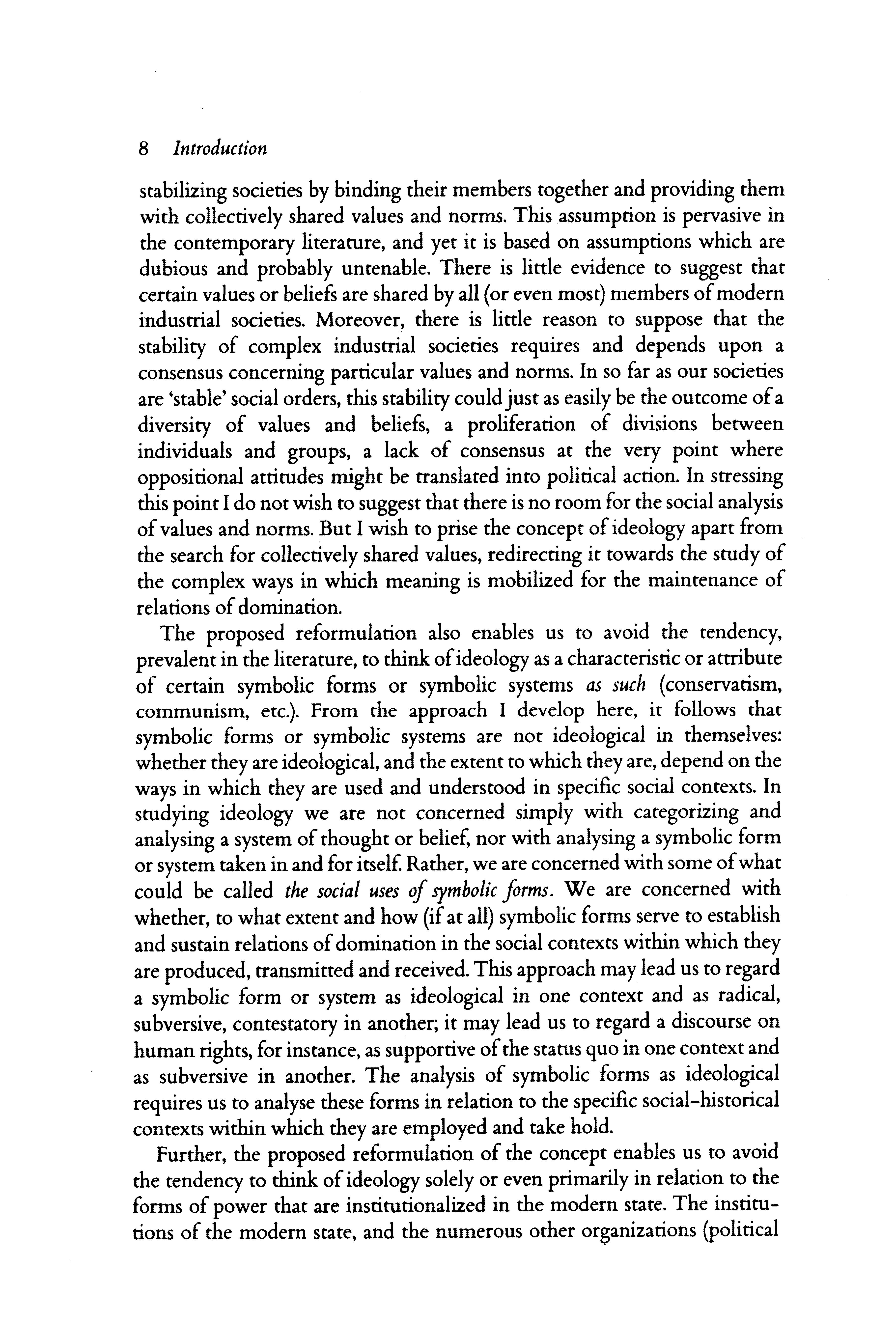
stabilizing societies by binding their members together and providing them with collectively shared values and norms. This assumption is pervasive in the contemporary literature, and yet it is based on assumptions which are dubious and probably untenable. There is little evidence to suggest that certain values or beliefs are shared by all (or even most) members of modern industrial societies. Moreover, there is little reason to suppose that the stability of complex industrial societies requires and depends upon a consensus concerning particular values and norms. In so far as our societies are 'stable' social orders, this stability could just as easily be the outcome of a diversity of values and beliefs, a proliferation of divisions between individuals and groups, a lack of consensus at the very point where oppositional attitudes might be translated into political action. In stressing this point I do not wish to suggest that there is no room for the social analysis of values and norms. But I wish to prise the concept of ideology apart from the search for collectively shared values, redirecting it towards the study of the complex ways in which meaning is mobilized for the maintenance of relations of domination.
The proposed reformulation also enables us to avoid the tendency, prevalent in the literature, to think of ideology as a characteristic or attribute of certain symbolic forms or symbolic systems as such (conservatism, communism, etc.). From the approach I develop here, it follows that symbolic forms or symbolic systems are not ideological in themselves: whether they are ideological, and the extent to which they are, depend on tl1e ways in which they are used and understood in specific social contexts. In studying ideology we are not concerned simply with categorizing and analysing a system of thought or belief, nor with analysing a symbolic form or system taken in and for itsel£ Rather, we are concerned with some of what could be called the social uses of symbolic forms. We are concerned with whether, to what extent and how (if at all) symbolic forms serve to establish and sustain relations of domination in the social contexts within which they are produced, transmitted and received. This approach may lead us to regard a symbolic form or system as ideological in one context and as radical, subversive, contestatory in another; it may lead us to regard a discourse on human rights, for instance, as supportive of the status quo in one context and as subversive in another. The analysis of symbolic forms as ideological requires us to analyse these forms in relation to the specific social-historical contexts within which they are employed and take hold.
Further, the proposed reformulation of the concept enables us to avoid the tendency to think of ideology solely or even primarily in relation to the forms of power that are institutionalized in the modern state. The institutions of the modern state, and the numerous other organizations (political
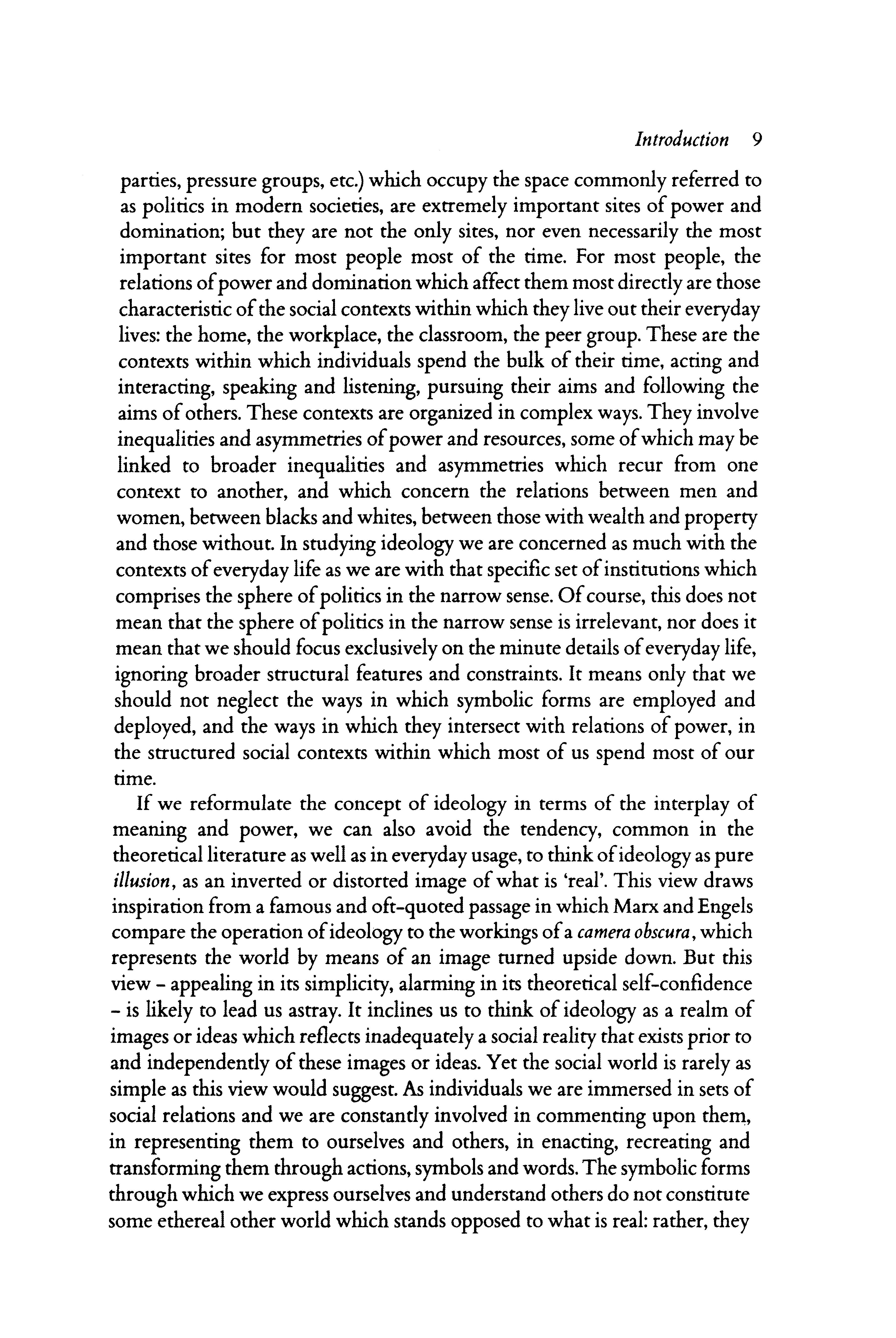
parries, pressure groups, etc.) which occupy the space commonly referred to as politics in modern societies, are extremely important sites of power and domination; but they are not the only sites, nor even necessarily the most important sites for most people most of the rime. For most people, the relations of power and domination which affect them most directly are those characteristic of the social contexts within which they live out their everyday lives: the home, the workplace, the classroom, the peer group. These are the contexts within which individuals spend the bulk of their rime, acting and interacting, speaking and listening, pursuing their aims and following the aims of others. These contexts are organized in complex ways. They involve inequalities and asymmetries of power and resources, some of which may be linked to broader inequalities and asymmetries which recur from one context to another, and which concern the relations between men and women, between blacks and whites, between those with wealth and property and those without. In studying ideology we are concerned as much with the contexts of everyday life as we are with that specific set of institutions which comprises the sphere of politics in the narrow sense. Of course, this does not mean that the sphere of politics in the narrow sense is irrelevant, nor does it mean that we should focus exclusively on the minute details of everyday life, ignoring broader structural features and constraints. It means only that we should not neglect the ways in which symbolic forms are employed and deployed, and the ways in which they intersect with relations of power, in the structured social contexts within which most of us spend most of our time.
If we reformulate the concept of ideology in terms of the interplay of meaning and power, we can also avoid the tendency, common in the theoretical literature as well as in everyday usage, to think of ideology as pure illusion, as an inverted or distorted image of what is 'real'. This view draws inspiration from a famous and oft-quoted passage in which Marx and Engels compare the operation of ideology to the workings of a camera obscura, which represents the world by means of an image turned upside down. But this view - appealing in its simplicity, alarming in its theoretical self-confidence - is likely to lead us asrray. It inclines us to think of ideology as a realm of images or ideas which reflects inadequately a social reality that exists prior to and independently of these images or ideas. Yet the social world is rarely as simple as this view would suggest. As individuals we are immersed in sets of social relations and we are constantly involved in commenting upon them, in representing them to ourselves and others, in enacting, recreating and transforming them through actions, symbols and words. The symbolic forms through which we express ourselves and understand others do not constitute some ethereal other world which stands opposed to what is real: rather, they
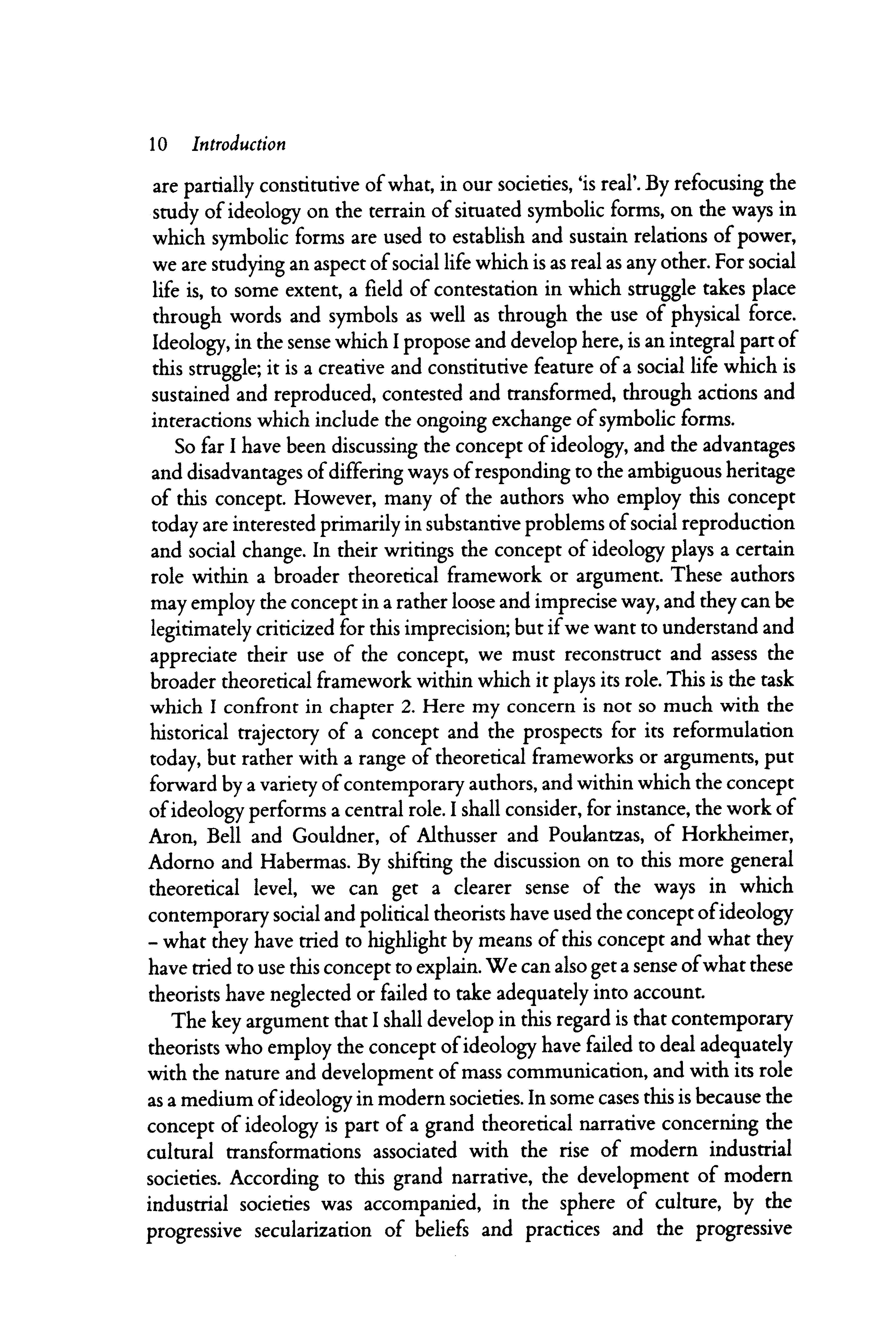
are partially constitutive of what, in our societies, 'is real'. By refocusing the study of ideology on the terrain of situated symbolic forms, on the ways in which symbolic forms are used to establish and sustain relations of power, we are studying an aspect of social life which is as real as any other. For social life is, to some extent, a field of contestation in which struggle takes place through words and symbols as well as through the use of physical force. Ideology, in the sense which I propose and develop here, is an integral part of this struggle; it is a creative and constitutive feature of a social life which is sustained and reproduced, contested and transformed, through actions and interactions which include the ongoing exchange of symbolic forms.
So far I have been discussing the concept of ideology, and the advantages and disadvantages of differing ways of responding to the ambiguous heritage of this concept. However, many of the authors who employ this concept today are interested primarily in substantive problems of social reproduction and social change. In their writings the concept of ideology plays a certain role within a broader theoretical framework or argument. These authors may employ the concept in a rather loose and imprecise way, and they can be legitimately criticized for this imprecision; but if we want to understand and appreciate their use of the concept, we must reconstruct and assess the broader theoretical framework within which it plays its role. This is the task which I confront in chapter 2. Here my concern is not so much with the historical trajectory of a concept and the prospects for its reformulation today, but rather with a range of theoretical frameworks or arguments, put forward by a variety of contemporary authors, and within which the concept of ideology performs a central role. I shall consider, for instance, the work of Aron, Bell and Gouldner, of Althusser and Poulantzas, of Horkheimer, Adorno and Habermas. By shifting the discussion on to this more general theoretical level, we can get a clearer sense of the ways in which contemporary social and political theorists have used the concept ofideology - what they have tried to highlight by means of this concept and what they have tried to use this concept to explain. We can also get a sense of what these theorists have neglected or failed co rake adequately into account.
The key argument that I shall develop in this regard is that contemporary theorists who employ the concept ofideology have failed to deal adequately with the nature and development of mass communication, and with its role as a medium of ideology in modern societies. In some cases this is because the concept of ideology is part of a grand theoretical narrative concerning the cultural transformations associated with the rise of modern industrial societies. According to this grand narrative, the development of modern industrial societies was accompanied, in the sphere of culture, by the progressive secularization of beliefs and practices and the progressive
Introduction ll
rationalization of social life. As religion and magic lost their hold on individuals caught up in the restless activity of capitalist industrialization, the ground was prepared for the emergence of a new kind of belief system: for the emergence of secular belief systems which could mobilize individuals without reference to other-worldly values or beings. It is these secular belief systems which some contemporary theorists describe as 'ideologies'. In their view, the development of industrial capitalism gave rise to an 'age of ideologies' which was inaugurated by the French Revolution and which culminated with the radical revolutionary movements of the early twentieth century. The grand narrative of cultural transformation thus allocates a specific role to the concept of ideology (understood as a neutral conception, in the sense explained above). The concept ofideology is used to describe the systems of belief which- this theoretical narrative alleges- filled the cultural vacuum created by the decline of religion and magic, and which provided people with new forms of consciousness, new frames of meaning, in a world undergoing rapid and unprecedented social change.
The grand narrative of cultural transformation is deeply embedded in the discourse of social and political theory. It has served as a general, often implicit, theoretical construct within which many authors have viewed and analysed the development of modem societies. I think that this narrative contains some insights which are important for understanding the conditions under which modern societies emerged out of medieval and early modern Europe. But the narrative is also misleading in certain fundamental respects. One such respect is this: the theorists of the grand narrative, I shall argue, have mis-identified the major cultural transformation associated with the development of modem societies. Preoccupied with the alleged process of secularization and rationalization, these theorists have tended to neglect a process of far greater significance which was taking place before their eyes: namely, the rapid proliferation of institutions of mass communication and the growth of networks of transmission through which commodified symbolic forms were made available to an ever-expanding domain of recipients. This is the process that I describe as the mediazation of modern culture. This process constitutes, in my view, one of the key transformations associated with the rise of modern societies. Understanding this process is essential for understanding the world today, a world which is increasingly traversed by institutionalized networks of communication, and in which the experience of individuals is increasingly mediated by technical systems of symbolic production and transmission. Understanding this process will also provide an alternative theoretical framework within which a reformulated concept of ideology can play some role.

The Mediazation of Modem Culture
In seeking to understand rhe process which I describe as the mediazation of modern culture, I begin with the concept of culture. What are we referring to when we speak of'culture', of that sphere of social life which has been, and continues to be, transformed by the development of mass communication? And how can we understand the development of mass communication as a development in the sphere of culture, as a cultural transformation? The concept of culture has a long and complicated history of its own, a history which has probably produced as many variants and as much ambiguity as the history of the concept of ideology. Nevertheless, I believe that the concept of culture remains an important and valuable notion and that, suitably reformulated, it defines a fundamental domain of social analysis. In chapter 3 I undertake the task of clarifying and reformulating the concept of culture. Following the work of anthropologists such as Geertz, I argue that the concept of culture can appropriately be used to refer, in a general way, to the symbolic character of social life, to the patterns of meaning embodied in the symbolic forms exchanged in social interaction. But this emphasis on the symbolic character of social life must be complemented by an emphasis on the fact- not always evident in the writings of Geertz- that symbolic forms are embedded in structured social contexts involving relations of power, forms of conflict, inequalities in terms of the distribution of resources, and so on. This dual emphasis defines what I call the 'structural conception' of culture. Cultural phenomena, on this account, may be seen as symbolic forms in structured contexts; and cultural analysis may be regarded as the study of the meaningful constitution and social conrextualization of symbolic forms.
To view symbolic forms as contextualized phenomena is to regard them as generally produced and received by individuals situated in specific socialhistorical contexts and endowed with resources and capacities of various kinds. Symbolic forms may bear the traces of their social conditions of production - in the way, for instance, that an utterance may be marked by the accent, idiom and tone of a particular social class or regional background. The social contextualization of symbolic forms also implies that these forms may become the objects of complex processes of valuation, evaluation and conflict. Here I focus on what I call processes ofvalorization - that is, processes by which and through which symbolic forms are ascribed a certain 'value'. There are two types of value which are particularly important in this regard. One type is what may be called 'symbolic value': the value that symbolic forms have by virtue of the ways in which they are esteemed by the individuals who produce and receive them, by virtue of the ways in which
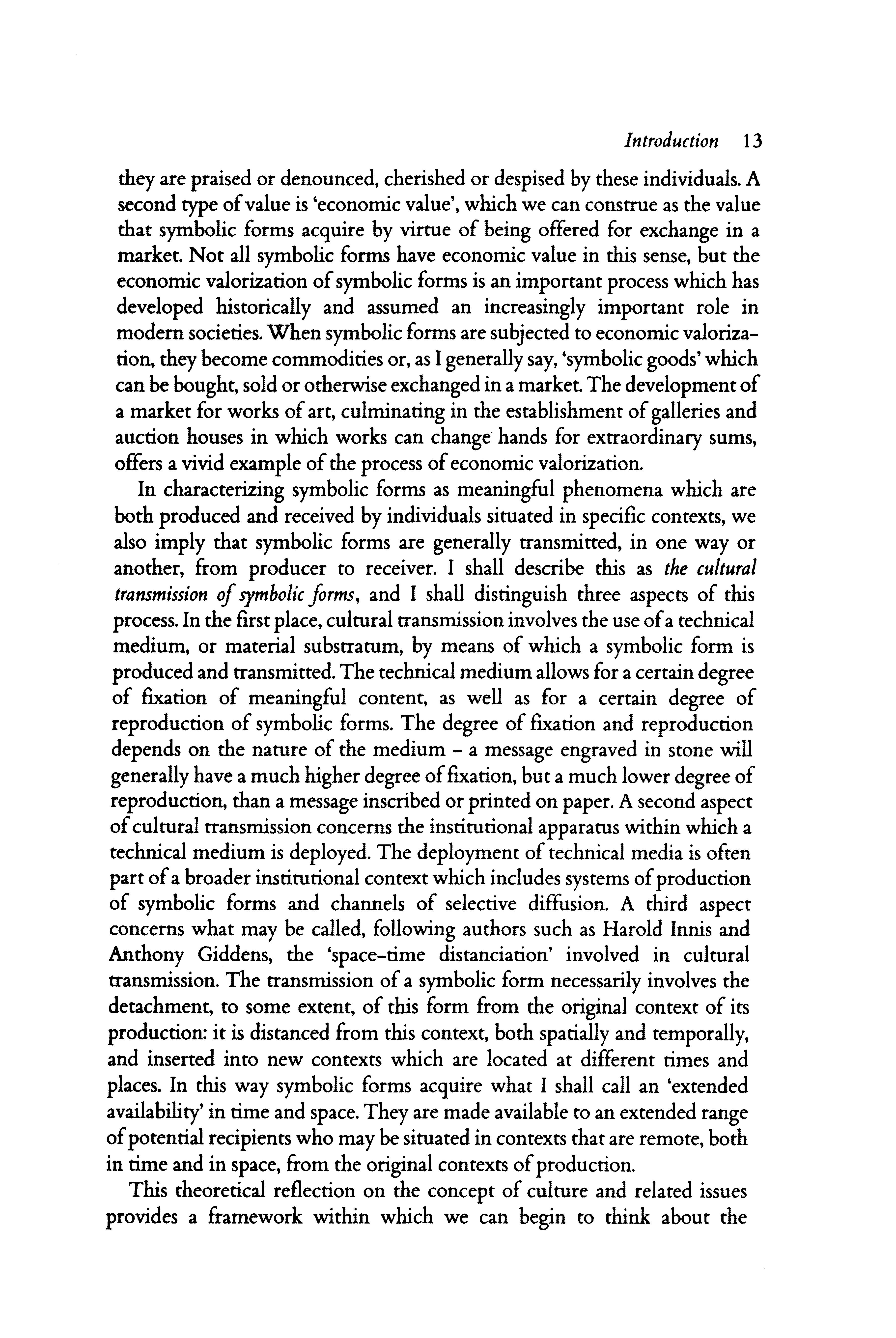
they are praised or denounced, cherished or despised by these individuals. A second type of value is 'economic value', which we can construe as the value that symbolic forms acquire by virtue of being offered for exchange in a market. Not all symbolic forms have economic value in this sense, but the economic valorization of symbolic forms is an important process which has developed historically and assumed an increasingly important role in modem societies. When symbolic forms are subjected to economic valorization, they become commodities or, as I generally say, 'symbolic goods' which can be bought, sold or otherwise exchanged in a market. The development of a market for works of art, culminating in the establishment of galleries and auction houses in which works can change hands for extraordinary sums, offers a vivid example of the process of economic valorization.
In characterizing symbolic forms as meaningful phenomena which are both produced and received by individuals situated in specific contexts, we also imply that symbolic forms are generally transmitted, in one way or another, from producer to receiver. I shall describe this as the cultural transmission of symbolic forms, and I shall distinguish three aspects of this process. In the first place, cultural transmission involves the use of a technical medium, or material substratum, by means of which a symbolic form is produced and transmitted. The technical medium allows for a certain degree of ftxarion of meaningful content, as well as for a certain degree of reproduction of symbolic forms. The degree of fixation and reproduction depends on the nature of the medium -a message engraved in stone will generally have a much higher degree of fixation, but a much lower degree of reproduction, than a message inscribed or printed on paper. A second aspect of cultural transmission concerns the institutional apparatus within which a technical medium is deployed. The deployment of technical media is often part of a broader institutional context which includes systems of production of symbolic forms and channels of selective diffusion. A third aspect concerns what may be called, following authors such as Harold Innis and Anthony Giddens, the 'space-rime distanciation' involved in cultural transmission. The transmission of a symbolic form necessarily involves the detachment, to some extent, of this form from the original context of its production: it is distanced from this context, both spatially and temporally, and inserted into new contexts which are located at different rimes and places. In this way symbolic forms acquire what I shall call an 'extended availability' in rime and space. They are made available to an extended range of potential recipients who may be situated in contexts that are remote, both in rime and in space, from the original contexts of production. This theoretical reflection on the concept of culture and related issues provides a framework within which we can begin to think about the
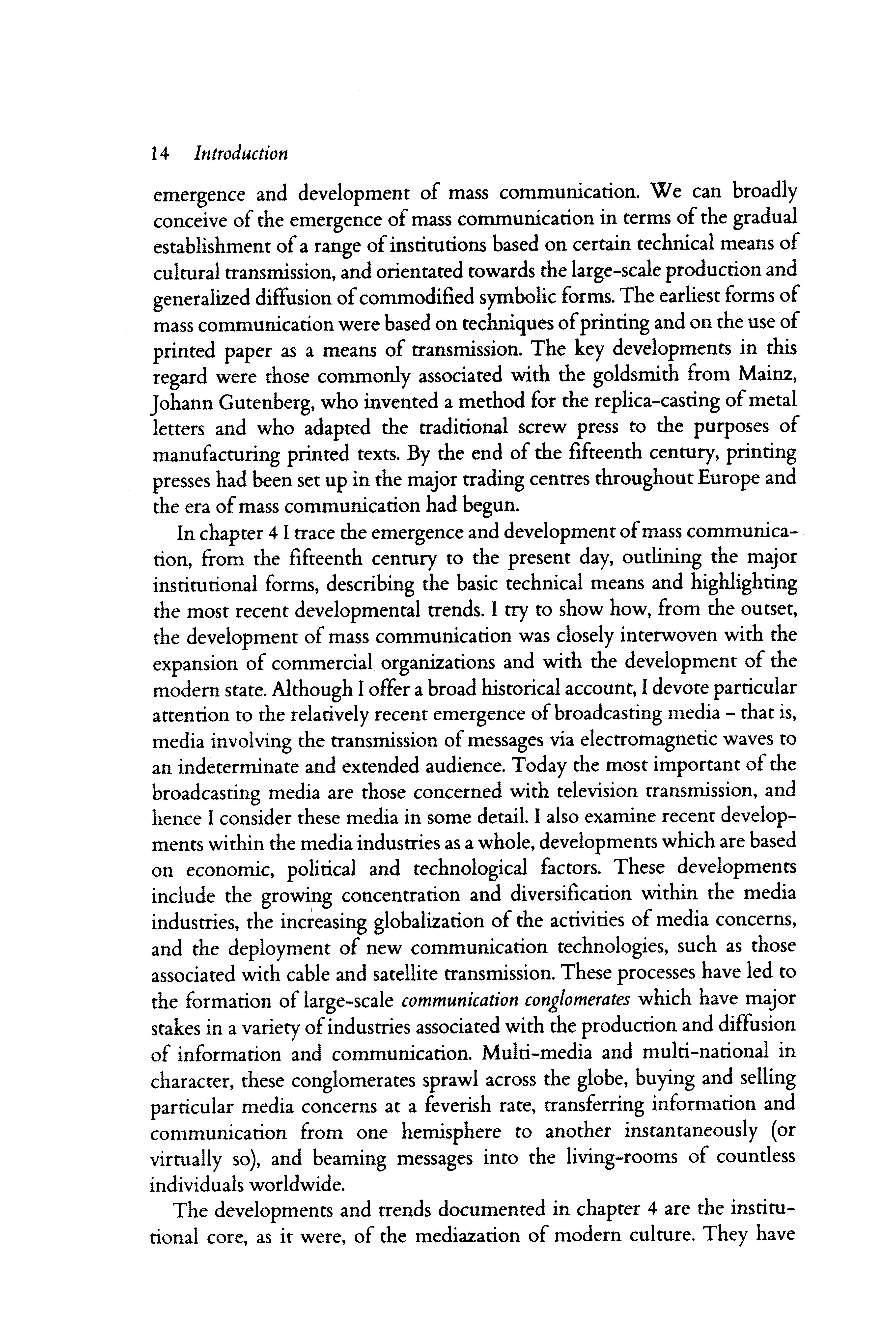
emergence and development of mass communication. We can broadly conceive of the emergence of mass communication in terms of the gradual establishment of a range of institutions based on certain technical means of cultural transmission, and orientated cowards the large-scale production and generalized diffusion of commodified symbolic forms. The earliest forms of mass communication were based on techniques of printing and on the use of printed paper as a means of transmission. The key developments in this regard were those commonly associated with the goldsmith from Mainz, Johann Gutenberg, who invented a method for the replica-casting of metal letters and who adapted the traditional screw press to the purposes of manufacturing printed texts. By the end of the fifteenth century, printing presses had been set up in the major trading centres throughout Europe and the era of mass communication had begun.
In chapter 4 I trace the emergence and development of mass communication, from the fifteenth century to the present day, outlining the major institutional forms, describing the basic technical means and highlighting the most recent developmental trends. I try to show how, from the outset, the development of mass communication was closely interwoven with the expansion of commercial organizations and with the development of the modern state. Although I offer a broad historical account, I devote particular attention to the relatively recent emergence of broadcasting media - that is, media involving the transmission of messages via electromagnetic waves to an indeterminate and extended audience. Today the most important of the broadcasting media are those concerned with television transmission, and hence I consider these media in some detail. I also examine recent developments within the media industries as a whole, developments which are based on economic, political and technological factors. These developments include the growing concentration and diversification within the media industries, the increasing globalization of the activities of media concerns, and the deployment of new communication technologies, such as those associated with cable and satellite transmission. These processes have led to the formation of large-scale communication conglomerates which have major stakes in a variety of industries associated with the production and diffusion of information and communication. Multi-media and multi-national in character, these conglomerates sprawl across the globe, buying and selling particular media concerns at a feverish rate, transferring information and communication from one hemisphere to another instantaneously (or virtually so), and beaming messages into the living-rooms of countless individuals worldwide.
The developments and trends documented in chapter 4 are the institutional core, as it were, of the mediazation of modern culture. They have

shaped, in a profound and irreversible way, the modes in which symbolic forms are produced, transmitted and received in modern societies, as well as the modes in which individuals experience the actions and events that take place in contexts from which they are spatially and temporally remote. These developments are partially constitutive of modern societies, and are partially constitutive of what is 'modern' about the societies in which we live today. That is, part of what constitutes modern societies as 'modern' is the fact that the exchange of symbolic forms is no longer restricted primarily to the contexts of face-to-face interaction, but is extensively and increasingly mediated by the institutions and mechanisms of mass communication. Of course, this process of the mediazation of modern culture is only one aspect of the formation of modern societies. It is a process which has gone hand-inhand with the development of industrial capitalism (and alternative forms of industrial development) and with the rise of the modern state (and associated forms of political participation). These processes have overlapped with one another in complex ways; they have taken different paths in different historical and geographical contexts. But together they have defined the basic contours of the societies in which we live today, contours which are becoming increasingly global in character.
What are the characteristics of the new regime of cultural transmission created by the advent of mass communication? How should we understand the nature of mass communication, the ways in which it affects social interaction, the role which it plays, and ought to play, in social and political life? These are the questions which I address in chapter 5, where I sketch the beginnings of a social theory of mass communication. I emphasize the fact that, while mass communication involves the exchange of symbolic forms, the kinds of communication established thereby are quite different from those involved in ordinary, day-to-day conversation. For mass communication generally involves a one-way flow of messages from the producer to the receiver. Unlike the dialogical situation of a conversation, in which a listener is also a potential respondent, mass communication institutes afundamental break between the producer and the receiver, in such a way that recipients have relatively little capacity to intervene in the communicative process and contribute to its course and content. Of course, recipients do have some capacity to intervene; they can, for insta!lce, write letters to the editor, phone television companies and express their views, or vote with their feet. But while particular institutions and technical media admit of various kinds of recipient response, the fundamental asymmetry of the communicative process remains intact.
This asymmetry has implications for what I call the interactional impact of technical media. I use this expression to refer to the ways in which the
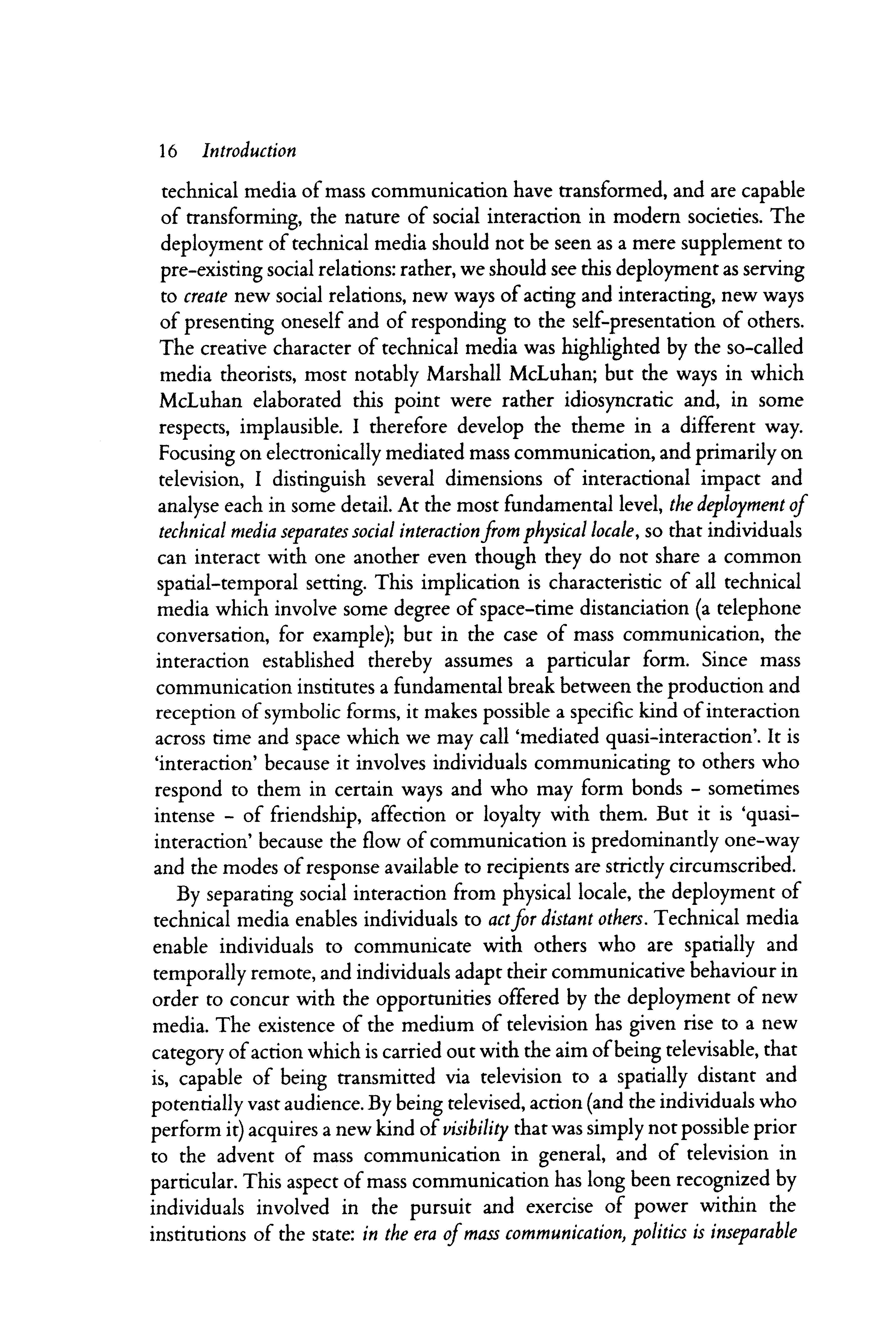
technical media of mass communication have transformed, and are capable of transforming, the nature of social interaction in modern societies. The deployment of technical media should not be seen as a mere supplement to pre-existing social relations: rather, we should see this deployment as serving to create new social relations, new ways of acting and interacting, new ways of presenting oneself and of responding to the self-presentation of others. The creative character of technical media was highlighted by the so-called media theorists, most notably Marshall McLuhan; but the ways in which McLuhan elaborated this point were rather idiosyncratic and, in some respects, implausible. I therefore develop the theme in a different way. Focusing on electronically mediated mass communication, and primarily on television, I distinguish several dimensions of interactional impact and analyse each in some detail. At the most fundamental level, the deployment of technical media separates social interaction ftom physical locale, so that individuals can interact with one another even though they do not share a common spatial-temporal setting. This implication is characteristic of all technical media which involve some degree of space-time distanciation (a telephone conversation, for example); bur in the case of mass communication, the interaction established thereby assumes a particular form. Since mass communication institutes a fundamental break between the production and reception of symbolic forms, it makes possible a specific kind of interaction across time and space which we may call 'mediated quasi-interaction'. It is 'interaction' because it involves individuals communicating to others who respond to them in certain ways and who may form bonds - sometimes intense - of friendship, affection or loyalty with them. But it is 'quasiinteraction' because the flow of communication is predominantly one-way and the modes of response available to recipients are strictly circumscribed. By separating social interaction from physical locale, the deployment of technical media enables individuals to act for distant others. Technical media enable individuals to communicate with others who are spatially and temporally remote, and individuals adapt their communicative behaviour in order to concur with the opportunities offered by the deployment of new media. The existence of the medium of television has given rise to a new category of action which is carried out with the aim ofbeing televisable, that is, capable of being transmitted via television to a spatially distant and potentially vast audience. By being televised, action (and the individuals who perform it) acquires a new kind of visibility that was simply not possible prior to the advent of mass communication in general, and of television in particular. This aspect of mass communication has long been recognized by individuals involved in the pursuit and exercise of power within the institutions of the state: in the era of mass communication, politics is inseparable
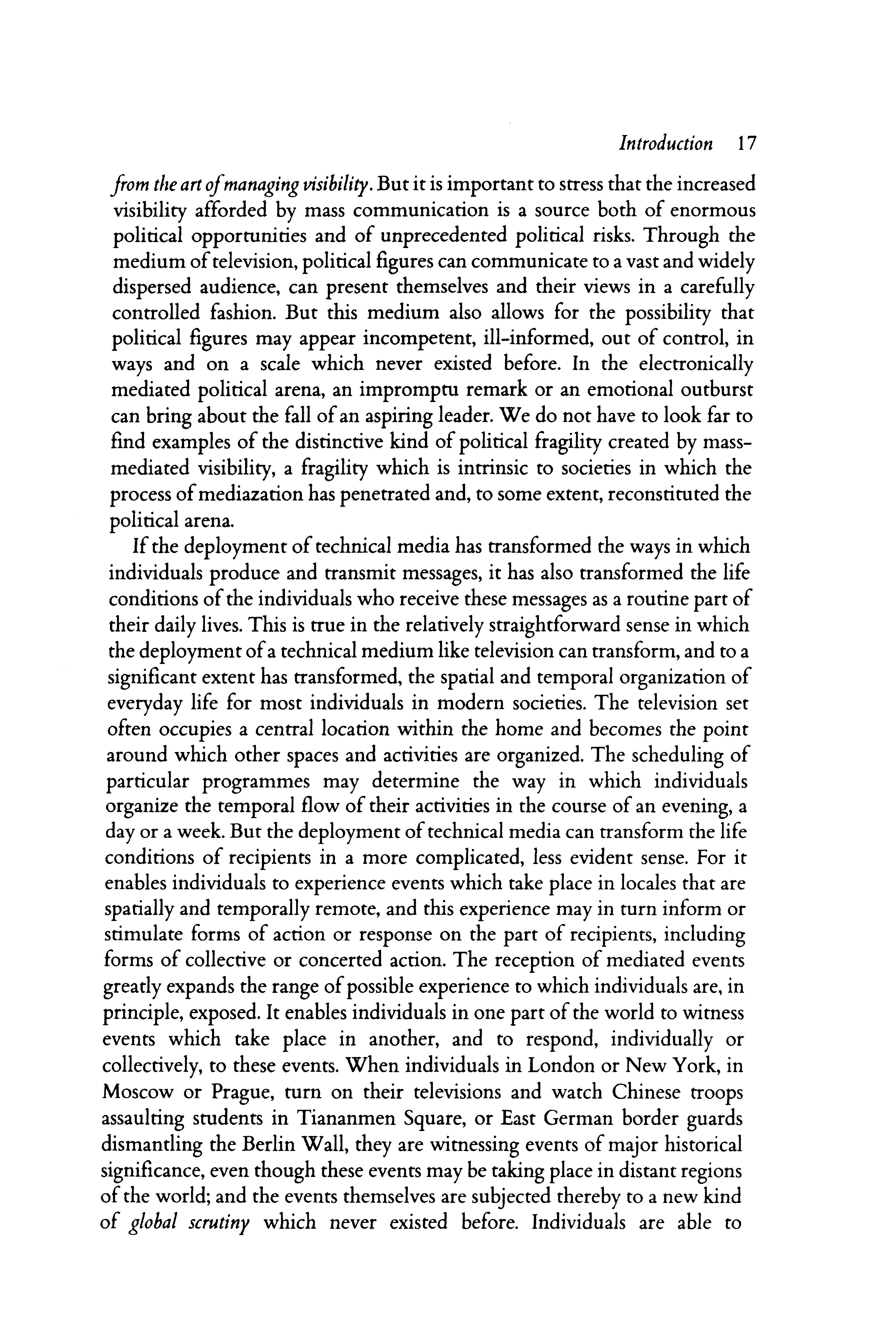
from the art ofmanaging visibility. But it is important to stress that the increased visibility afforded by mass communication is a source both of enormous political opportunities and of unprecedented political risks. Through the medium of television, political figures can communicate to a vast and widely dispersed audience, can present themselves and their views in a carefully controlled fashion. But this medium also allows for the possibility that political figures may appear incompetent, ill-informed, out of control, in ways and on a scale which never existed before. In the electronically mediated political arena, an impromptu remark or an emotional outburst can bring about the fall of an aspiring leader. We do not have to look far to find examples of the distinctive kind of political fragility created by massmediated visibility, a fragility which is intrinsic to societies in which the process of mediazation has penetrated and, to some extent, reconstituted the political arena.
If the deployment of technical media has transformed the ways in which individuals produce and transmit messages, it has also transformed the life conditions of the individuals who receive these messages as a routine part of their daily lives. This is true in the relatively straightforward sense in which the deployment of a technical medium like television can transform, and to a significant extent has transformed, the spatial and temporal organization of everyday life for most individuals in modern societies. The television set often occupies a central location within the home and becomes the point around which other spaces and activities are organized. The scheduling of particular programmes may determine the way in which individuals organize the temporal flow of their activities in the course of an evening, a day or a week. But the deployment of technical media can transform the life conditions of recipients in a more complicated, less evident sense. For it enables individuals to experience events which take place in locales that are spatially and temporally remote, and this experience may in turn inform or stimulate forms of action or response on the part of recipients, including forms of collective or concerted action. The reception of mediated events greatly expands the range of possible experience to which individuals are, in principle, exposed. It enables individuals in one part of the world to witness events which take place in another, and to respond, individually or collectively, to these events. When individuals in London or New York, in Moscow or Prague, turn on their televisions and watch Chinese troops assaulting students in Tiananmen Square, or East German border guards dismantling the Berlin Wall, they are witnessing events of major historical significance, even though these events may be taking place in distant regions of the world; and the events themselves are subjected thereby to a new kind of global scrutiny which never existed before. Individuals are able to
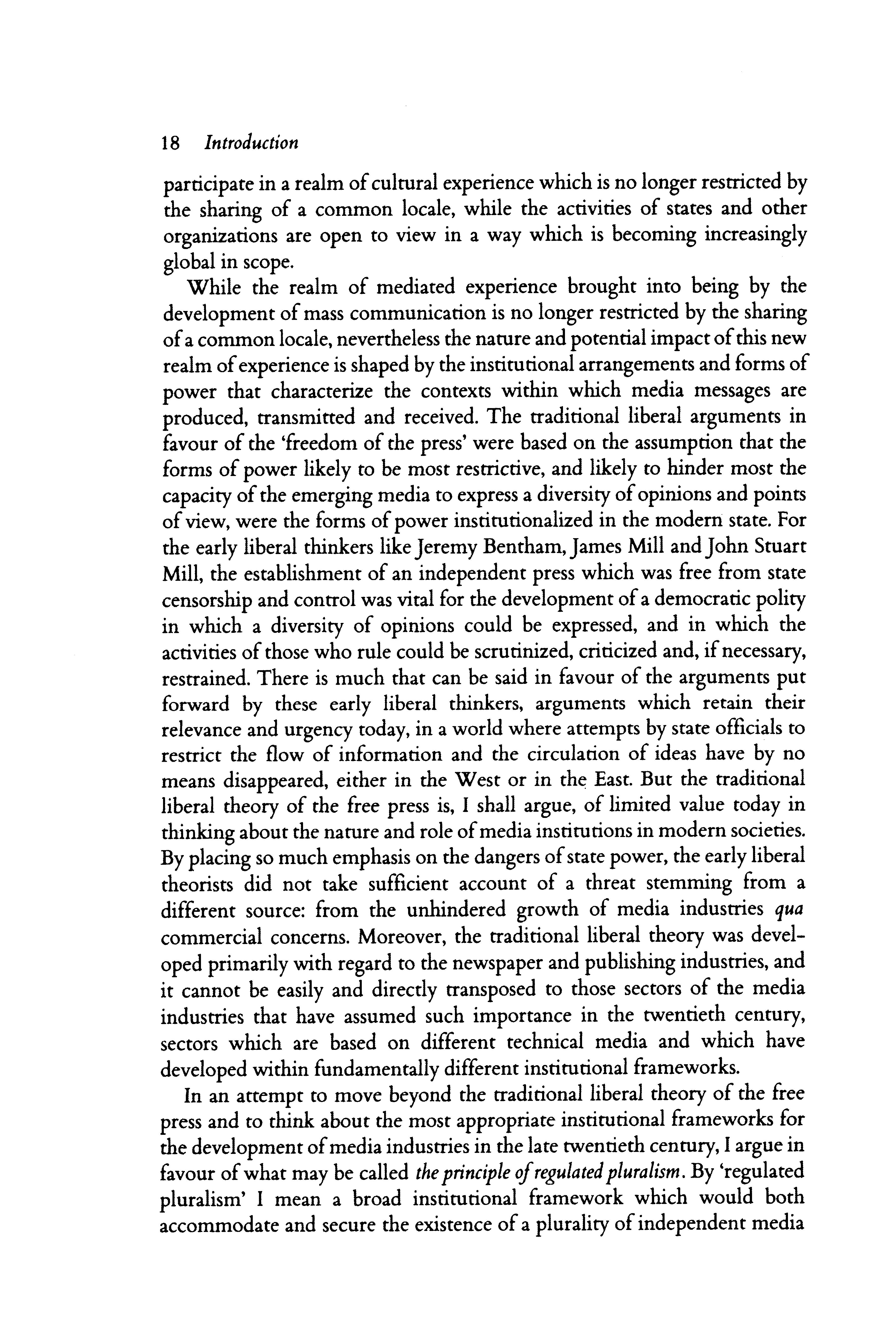
participate in a realm of cultural experience which is no longer restricted by the sharing of a common locale, while the activities of states and other organizations are open to view in a way which is becoming increasingly global in scope.
While the realm of mediated experience brought into being by the development of mass communication is no longer restricted by the sharing of a common locale, nevertheless the nature and potential impact of this new realm of experience is shaped by the institutional arrangements and forms of power that characterize the contexts within which media messages are produced, transmitted and received. The traditional liberal arguments in favour of the 'freedom of the press' were based on the assumption that the forms of power likely to be most restrictive, and likely to hinder most the capacity of the emerging media to express a diversity of opinions and points of view, were the forms of power institutionalized in the modern state. For the early liberal thinkers like Jeremy Bentham, James Mill and John Stuart Mill, the establishment of an independent press which was free from state censorship and control was vital for the development of a democratic polity in which a diversity of opinions could be expressed, and in which the activities of those who rule could be scrutinized, criticized and, if necessary, restrained. There is much that can be said in favour of the arguments put forward by these early liberal thinkers, arguments which retain their relevance and urgency today, in a world where attempts by state officials to restrict the flow of information and the circulation of ideas have by no means disappeared, either in the West or in the East. But the traditional liberal theory of the free press is, I shall argue, of limited value today in thinking about the nature and role of media institutions in modern societies. By placing so much emphasis on the dangers of state power, the early liberal theorists did not take sufficient account of a threat stemming from a different source: from the unhindered growth of media industries qua commercial concerns. Moreover, the traditional liberal theory was developed primarily with regard to the newspaper and publishing industries, and it cannot be easily and directly transposed to those sectors of the media industries that have assumed such importance in the twentieth century, sectors which are based on different technical media and which have developed within fundamentally different institutional frameworks.
In an attempt to move beyond the traditional liberal theory of the free press and to think about the most appropriate institutional frameworks for the development of media industries in the late twentieth century, I argue in favour of what may be called the principle of regulated pluralism. By 'regulated pluralism' I mean a broad institutional framework which would both accommodate and secure the existence of a plurality of independent media
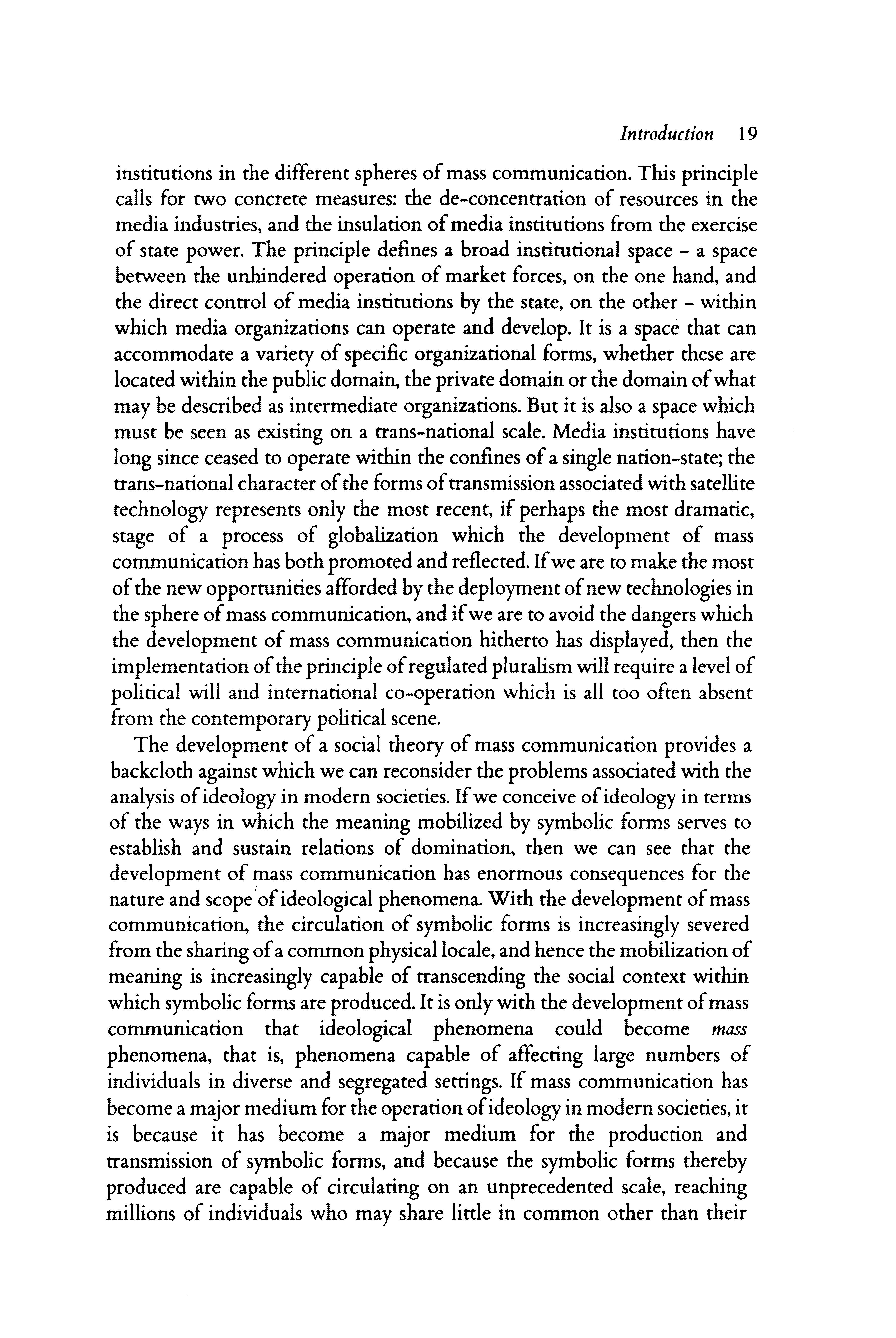
institutions in the different spheres of mass communication. This principle calls for two concrete measures: the de-concentration of resources in the media industries, and the insulation of media institutions from the exercise of state power. The principle defines a broad institutional space -a space between the unhindered operation of market forces, on the one hand, and the direct control of media institutions by the state, on the other - within which media organizations can operate and develop. It is a space that can accommodate a variety of specific organizational forms, whether these are located within the public domain, the private domain or the domain of what may be described as intermediate organizations. But it is also a space which must be seen as existing on a trans-national scale. Media institutions have long since ceased to operate within the confines of a single nation-state; the trans-national character of the forms of transmission associated with satellite technology represents only the most recent, if perhaps the most dramatic, stage of a process of globalization which the development of mass communication has both promoted and reflected. If we are to make the most of the new opportunities afforded by the deployment of new technologies in the sphere of mass communication, and if we are to avoid the dangers which the development of mass communication hitherto has displayed, then the implementation of the principle of regulated pluralism will require a level of political will and international co-operation which is all too often absent from the contemporary political scene.
The development of a social theory of mass communication provides a backcloth against which we can reconsider the problems associated with the analysis of ideology in modern societies. If we conceive of ideology in terms of the ways in which the meaning mobilized by symbolic forms serves to establish and sustain relations of domination, then we can sec that the development of mass communication has enormous consequences for the nature and scope, of ideological phenomena. With the development of mass communication, the circulation of symbolic forms is increasingly severed from the sharing of a common physical locale, and hence the mobilization of meaning is increasingly capable of transcending the social context within which symbolic forms are produced. It is only with the development of mass communication that ideological phenomena could become mass phenomena, that is, phenomena capable of affecting large numbers of individuals in diverse and segregated settings. If mass communication has become a major medium for the operation of ideology in modern societies, it is because it has become a major medium for the production and transmission of symbolic forms, and because the symbolic forms thereby produced are capable of circulating on an unprecedented scale, reaching millions of individuals who may share little in common other than their

20 Introduction
capacity to receive mass-mediated messages. But while the significance of mass communication should not be underestimated, we must add two qualifications. Mass communication has become a major medium of ideology in modern societies, but it is by no means the only medium. It is important to stress that ideology - understood broadly as meaning in the service of power - operates in a variety of contexts in everyday life, from ordinary conversations between friends to ministerial addresses on prime time television. Those concerned with the theory and analysis of ideology would be mistaken to focus exclusively on mass communication, just as they would be misguided if they ignored it. The second qualification is this: while the development of mass communication has created a new set of parameters for the operation of ideology in modern societies, the question of whether particular mass-mediated messages are ideological is a question which cannot be answered abstractly, but which must be pursued within the framework of a systematic interpretative methodology. Only in this way can we avoid the tendency - all coo common in the literature - co assume that certain media messages are ideological as such and efficacious throughout the social world. The elaboration of a systematic methodology will enable us to develop an approach to the ideological character of media messages which is both more rigorous and more restrained.
The Methodology oflnterpretation
Most of this book is concerned with problems of a general theoretical nature - the concept and role of ideology, the concept of culture and the characteristics of cultural transmission, the development of mass communication and its implications for social and political life. But an essential part of my argument is that these general theoretical problems can be, and should be, conjoined with issues of a more concrete, methodological .. character. In chapter 6 I explore some of the connections between theory and methodology, between theoretical reflection and methodical, detailed inquiry. My aim is not so much to prescribe or proscribe particular methods of research, but rather to outline a broad methodological framework within which particular methods can be situated and related to one another, and within which their value (as well as their limits) can be appraised.
In developing this framework, I draw on a particular tradition of thought, a tradition that is commonly known as hermeneutics. Why hermeneutics? What does this ancient tradition of thought, stemming from Classical Greece, have co offer the student of modern culture? We can answer this question on two levels. On a general level, this tradition calls our attention to
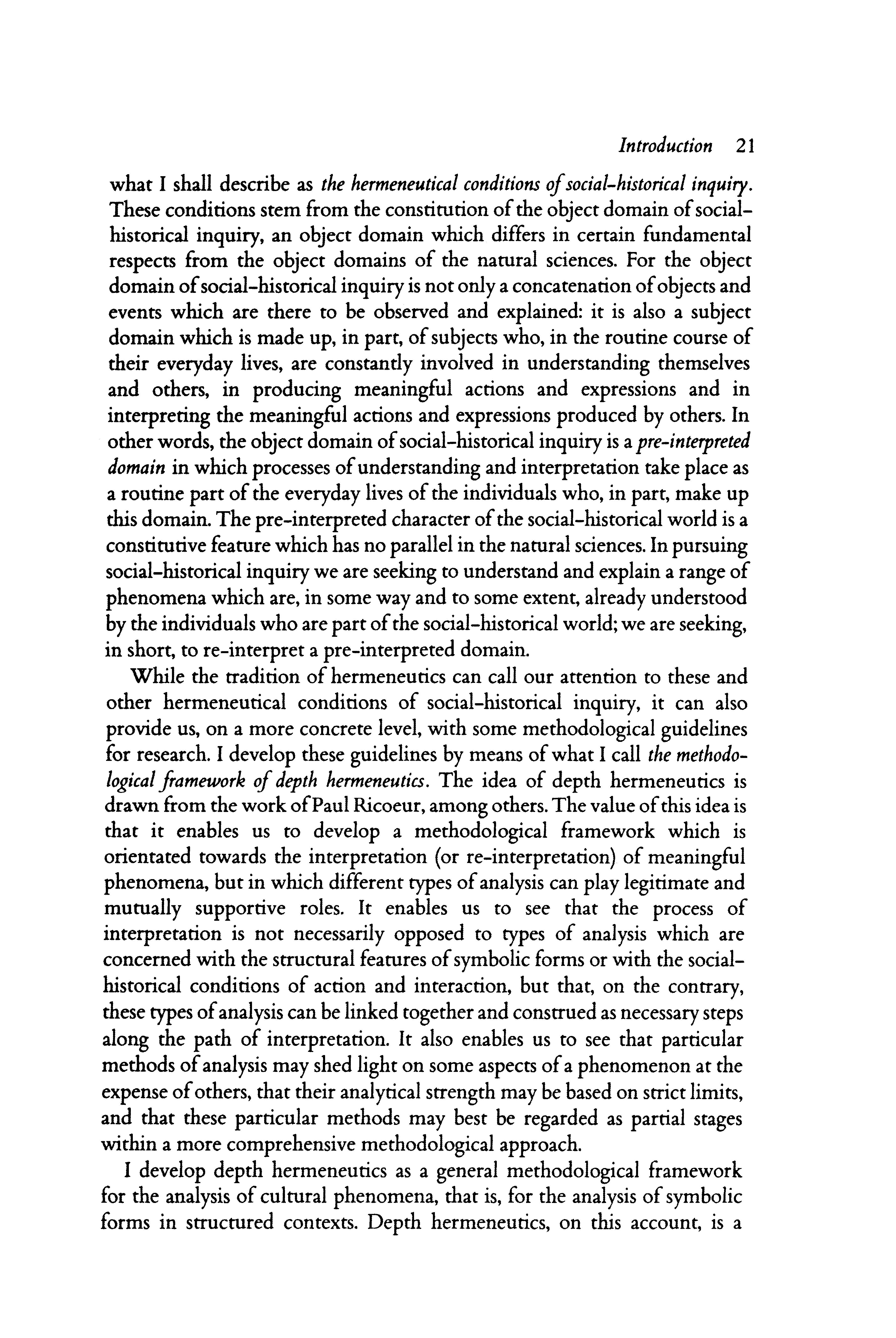
what I shall describe as the hermeneutical conditions of social-historical inquiry. These conditions stem from the constitution of the object domain of socialhistorical inquiry, an object domain which differs in certain fundamental respects from the object domains of the natural sciences. For the object domain of social-historical inquiry is not only a concatenation of objects and events which are there to be observed and explained: it is also a subject domain which is made up, in part, of subjects who, in the routine course of their everyday lives, are constantly involved in understanding themselves and others, in producing meaningful actions and expressions and in interpreting the meaningful actions and expressions produced by others. In other words, the object domain of social-historical inquiry is a pre-interpreted domain in which processes of understanding and interpretation take place as a routine part of the everyday lives of the individuals who, in part, make up this domain. The pre-interpreted character of the social-historical world is a constitutive feature which has no parallel in the natural sciences. In pursuing social-historical inquiry we are seeking to understand and explain a range of phenomena which are, in some way and to some extent, already understood by the individuals who are part of the social-historical world; we are seeking, in short, to re-interpret a pre-interpreted domain.
While the tradition of hermeneutics can call our attention to these and other hermeneutical conditions of social-historical inquiry, it can also provide us, on a more concrete level, with some methodological guidelines for research. I develop these guidelines by means of what I call the methodological framework of depth hermeneutics. The idea of depth hermeneutics is drawn from the work ofPaul Ricoeur, among others. The value of this idea is that it enables us to develop a methodological framework which is orientated towards the interpretation (or re-interpretation) of meaningful phenomena, but in which different types of analysis can play legitimate and mutually supportive roles. It enables us to see that the process of interpretation is not necessarily opposed to types of analysis which are concerned with the structural features of symbolic forms or with the socialhistorical conditions of action and interaction, but that, on the contrary, these types of analysis can be linked together and construed as necessary steps along the path of interpretation. It also enables us to see that particular methods of analysis may shed light on some aspects of a phenomenon at the expense of others, that their analytical strength may be based on strict limits, and that these particular methods may best be regarded as partial stages within a more comprehensive methodological approach.
I develop depth hermeneutics as a general methodological framework for the analysis of cultural phenomena, that is, for the analysis of symbolic forms in structured contexts. Depth hermeneutics, on this account, is a
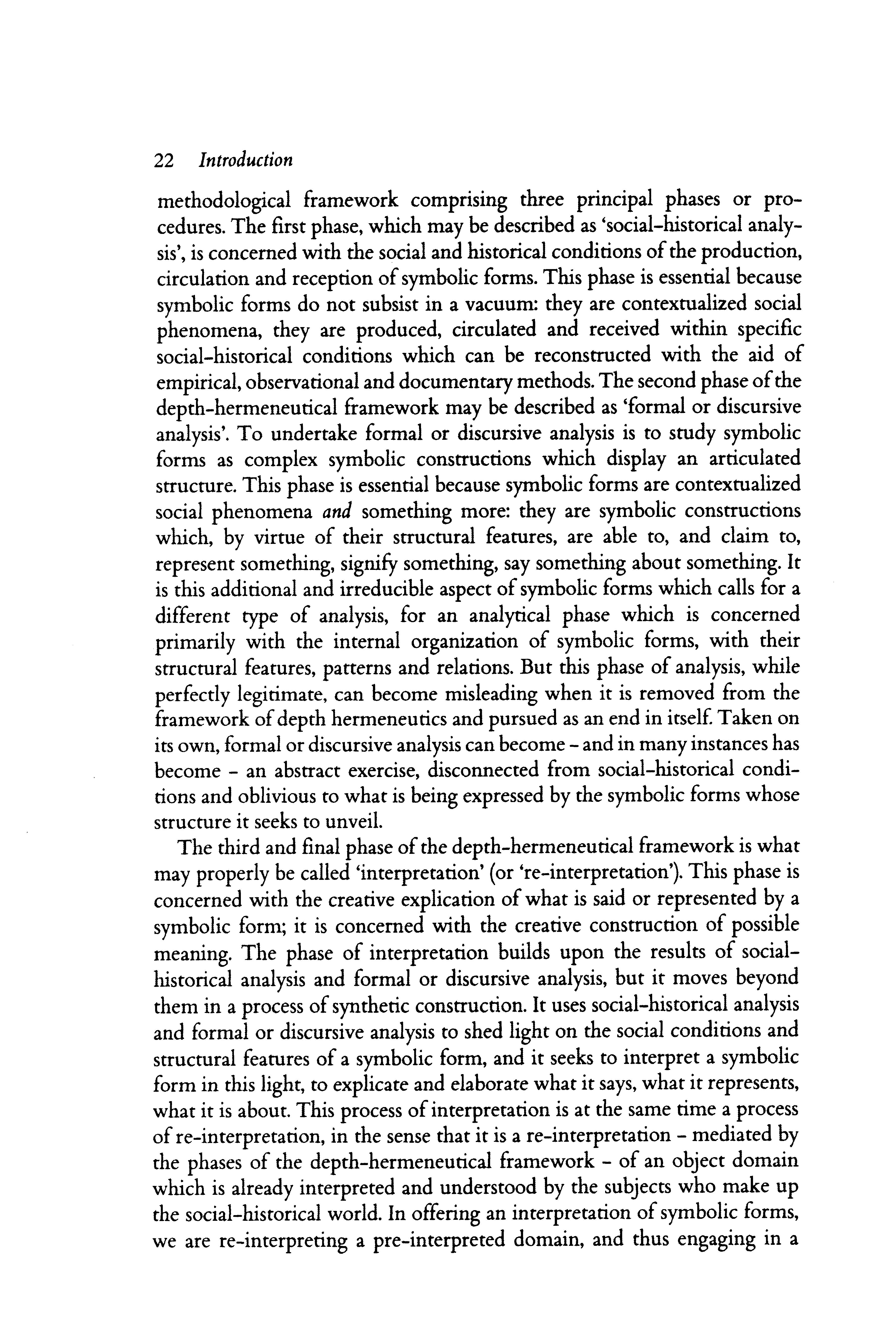
methodological framework compnsmg three principal phases or procedures. The first phase, which may be described as 'social-historical analysis', is concerned with the social and historical conditions of the production, circulation and reception of symbolic forms. This phase is essential because symbolic forms do not subsist in a vacuum: they are contextualized social phenomena, they are produced, circulated and received within specific social-historical conditions which can be reconstructed with the aid of empirical, observational and documentary methods. The second phase of the depth-hermeneutical framework may be described as 'formal or discursive analysis'. To undertake formal or discursive analysis is to study symbolic forms as complex symbolic constructions which display an articulated structure. This phase is essential because symbolic forms are contextualized social phenomena and something more: they are symbolic constructions which, by virtue of their structural features, are able to, and claim to, represent something, signify something, say something about something. It is this additional and irreducible aspect of symbolic forms which calls for a different type of analysis, for an analytical phase which is concerned primarily with the internal organization of symbolic forms, with their structural features, patterns and relations. But this phase of analysis, while perfectly legitimate, can become misleading when it is removed from the framework of depth hermeneutics and pursued as an end in itsel£ Taken on its own, formal or discursive analysis can become- and in many instances has become - an abstract exercise, disconnected from social-historical conditions and oblivious to what is being expressed by the symbolic forms whose structure it seeks to unveil.
The third and final phase of the depth-hermeneutical framework is what may properly be called 'interpretation' (or 're-interpretation'). This phase is concerned with the creative explication of what is said or represented by a symbolic form; it is concerned with the creative construction of possible meaning. The phase of interpretation builds upon the results of socialhistorical analysis and formal or discursive analysis, but it moves beyond them in a process of synthetic construction. It uses social-historical analysis and formal or discursive analysis to shed light on the social conditions and structural features of a symbolic form, and it seeks to interpret a symbolic form in this light, to explicate and elaborate what it says, what it represents, what it is about. This process of interpretation is at the same time a process of re-interpretation, in the sense that it is a re-interpretation- mediated by the phases of the depth-hermeneutical framework - of an object domain which is already interpreted and understood by the subjects who make up the social-historical world. In offering an interpretation of symbolic forms, we are re-interpreting a pre-interpreted domain, and thus engaging in a


